Facts about rheumatic fever. Rheumatic Fever: Causes, Symptoms, and Global Impact – 5 Key Facts
What are the main causes of rheumatic fever. How does rheumatic fever affect communities worldwide. What is the connection between rheumatic fever and rheumatic heart disease. Who is most at risk for developing rheumatic fever. How can rheumatic fever be prevented and treated.
The Global Burden of Rheumatic Fever
Rheumatic fever remains a significant global health concern, with nearly 470,000 new cases reported annually worldwide. This inflammatory disease, which can lead to serious complications, claims approximately 305,000 lives each year due to rheumatic heart disease. While developed countries like the United States have made significant strides in prevention and treatment, many regions around the world still lack access to essential medications, leaving vulnerable populations at risk.
Understanding the Causes of Rheumatic Fever
Rheumatic fever is primarily caused by poorly treated streptococcal infections, specifically those stemming from Group A Streptococcus (group A strep) bacteria. These infections can manifest as strep throat, scarlet fever, or streptococcal toxic shock syndrome. In regions with limited access to healthcare and antibiotics, particularly in parts of Africa and Asia, the incidence of rheumatic fever is significantly higher.
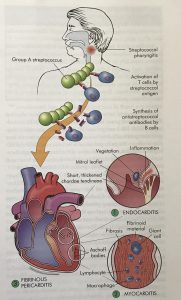
How does rheumatic fever develop?
When the body repeatedly fights strep infections, it can trigger an autoimmune response that leads to inflammation and scarring of heart valves and other tissues. This inflammatory condition is known as rheumatic fever. While antibiotics can effectively treat strep throat and scarlet fever, the complications arising from rheumatic fever are more challenging to manage.
The Link Between Rheumatic Fever and Rheumatic Heart Disease
One of the most severe complications of rheumatic fever is rheumatic heart disease (RHD). This condition occurs when rheumatic fever causes permanent scarring on the heart valves, leading to valve narrowing or leakage. As a result, the heart struggles to pump blood efficiently, eventually leading to heart failure and, in severe cases, death.
Where is rheumatic heart disease most prevalent?
While relatively uncommon in developed nations, rheumatic heart disease remains the primary cause of heart disease in children and young adults in underdeveloped regions of Asia, sub-Saharan Africa, and Latin America. The lack of access to proper healthcare and early intervention contributes significantly to this disparity.
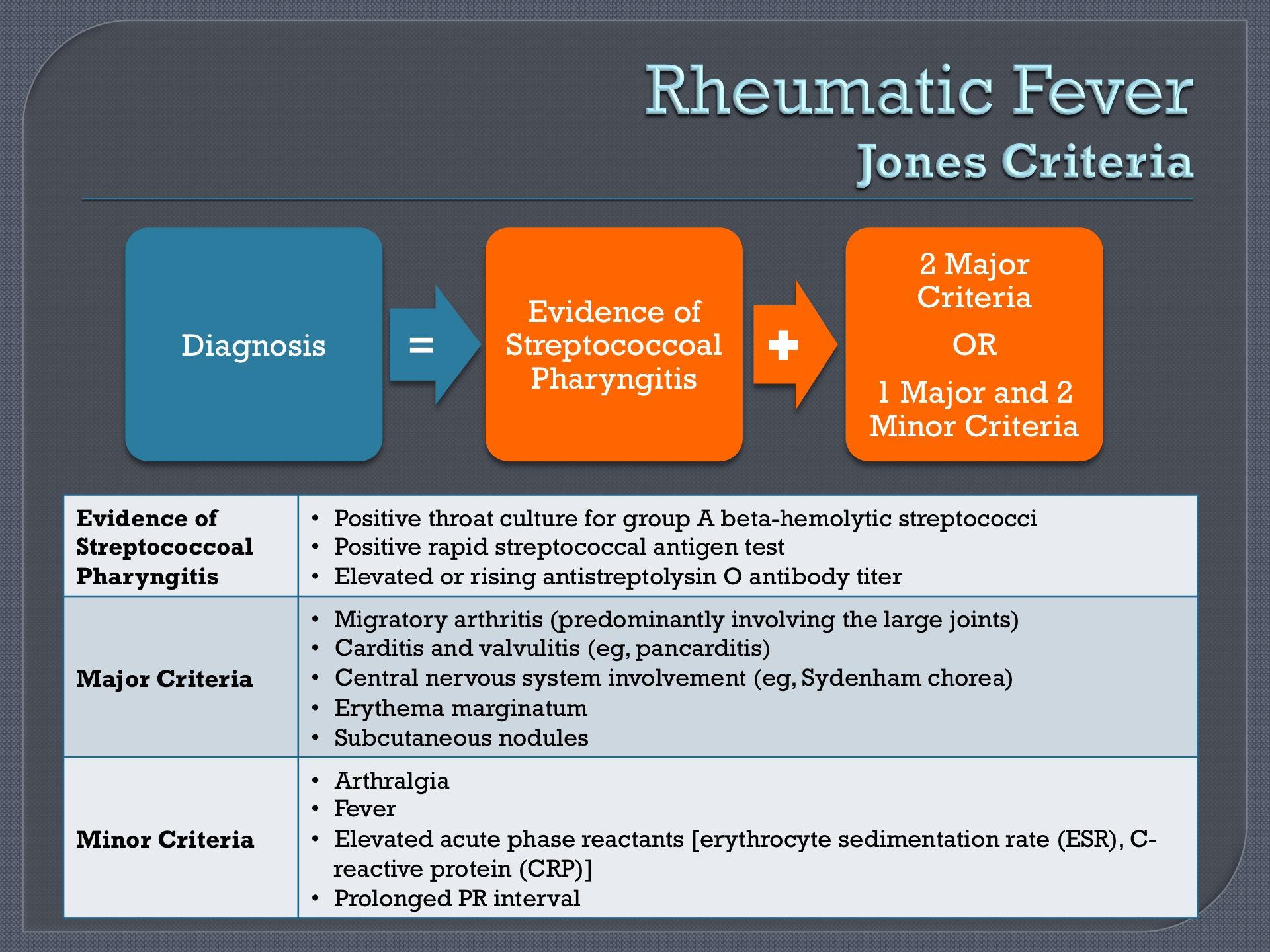
The Disproportionate Impact on Indigenous Communities
Rheumatic fever and rheumatic heart disease have a particularly devastating effect on certain indigenous populations. In Australia, for instance, these conditions disproportionately affect Torres Strait Islander and Māori communities, with some of the highest incidence rates globally.
- In 2018, indigenous Australian communities reported 59 cases of rheumatic fever per 100,000 people.
- In contrast, non-indigenous Australian communities reported less than one case per 100,000 people.
- Approximately 94% of rheumatic fever cases in Australia occur in indigenous communities.
These stark disparities highlight the urgent need for improved healthcare access, reduced overcrowding, and better living conditions in affected communities.
Children at Highest Risk: Age and Vulnerability
Rheumatic fever predominantly affects children between the ages of 5 and 15. This vulnerability stems from several factors, including:
- Naturally weaker immune systems due to limited exposure to various illnesses
- Higher susceptibility to strep infections
- Increased risk from repeated and untreated strep infections
As a result, rheumatic heart disease has become the most common type of heart disease in children globally. This underscores the critical importance of early detection and treatment of strep infections in pediatric populations.

RHD Action: A Global Initiative Against Rheumatic Heart Disease
In response to the global burden of rheumatic fever and rheumatic heart disease, RHD Action has emerged as a united force of three organizations dedicated to eradicating these conditions. The World Heart Federation, Reach, and the Medtronic Foundation have joined forces to raise awareness, provide resources, and improve access to care.
What are the key initiatives of RHD Action?
RHD Action focuses on several crucial areas:
- Raising awareness about the importance of diagnosing and treating strep infections
- Providing resources for families of children with rheumatic fever and rheumatic heart disease
- Educating people in developed countries about the importance of access to medicine and quality care
- Implementing programs in high-risk areas, including refugee camps in Uganda and regions of Brazil
Through these efforts, RHD Action aims to reduce the global burden of rheumatic fever and its complications.
Prevention and Treatment Strategies
While there is currently no cure for rheumatic heart disease or the complications arising from rheumatic fever, prevention remains the most effective strategy. Key preventive measures include:

- Early diagnosis and treatment of strep infections with antibiotics
- Improving access to healthcare in underserved communities
- Enhancing living conditions and reducing overcrowding
- Raising awareness about the importance of seeking medical attention for sore throats and other potential strep symptoms
For those already affected by rheumatic fever, ongoing management may involve:
- Long-term antibiotic prophylaxis to prevent recurrent strep infections
- Regular cardiac monitoring
- Management of symptoms and complications
- In severe cases, surgical interventions such as heart valve repair or replacement
The Role of Education and Awareness in Combating Rheumatic Fever
Education plays a crucial role in the fight against rheumatic fever and its complications. By increasing awareness about the disease, its causes, and prevention strategies, communities can take proactive steps to reduce its incidence. Key areas of focus include:
- Teaching proper hygiene practices to reduce the spread of strep infections
- Educating parents and caregivers about the importance of completing full courses of antibiotics
- Raising awareness about the signs and symptoms of strep throat and rheumatic fever
- Promoting regular health check-ups, especially in high-risk populations
By empowering communities with knowledge, we can work towards reducing the global burden of rheumatic fever and improving health outcomes for affected individuals.
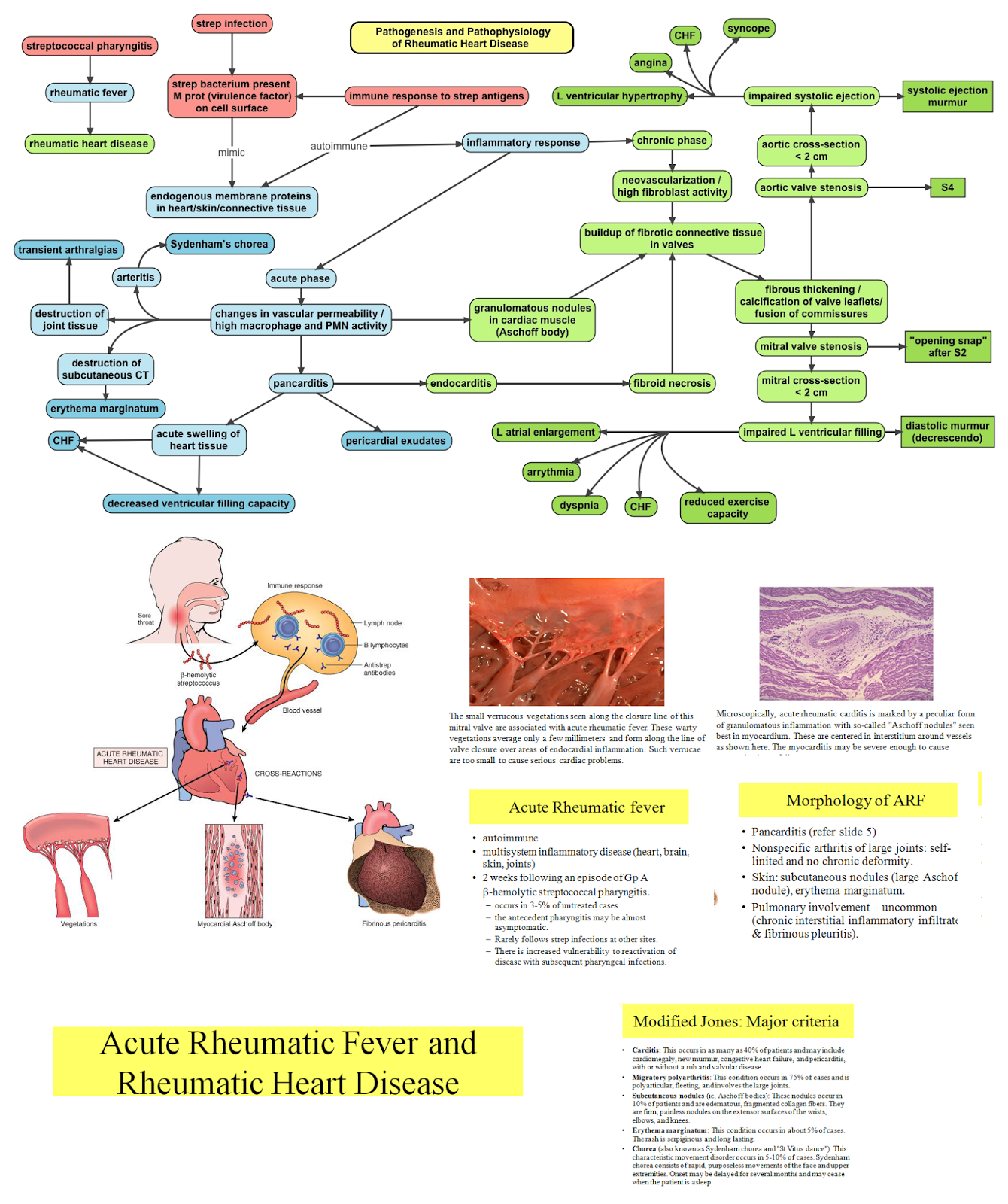
How can healthcare systems improve to address rheumatic fever?
To effectively combat rheumatic fever and its complications, healthcare systems worldwide need to focus on:
- Improving access to primary care services, especially in underserved areas
- Strengthening diagnostic capabilities for strep infections and rheumatic fever
- Ensuring a consistent supply of affordable antibiotics for treatment and prophylaxis
- Implementing surveillance systems to monitor the incidence and prevalence of rheumatic fever
- Developing and implementing national strategies for rheumatic fever prevention and control
By addressing these key areas, healthcare systems can significantly contribute to reducing the global burden of rheumatic fever and its associated complications.
The Economic Impact of Rheumatic Fever and RHD
Beyond the health implications, rheumatic fever and rheumatic heart disease also have significant economic consequences. These conditions can lead to:
- Increased healthcare costs for affected individuals and families
- Lost productivity due to illness and disability
- Strain on healthcare systems, particularly in resource-limited settings
- Long-term economic burden on communities with high prevalence rates
Addressing rheumatic fever and its complications is not only a matter of public health but also an investment in the economic well-being of affected communities.

How can we quantify the economic burden of rheumatic fever?
To better understand and address the economic impact of rheumatic fever, researchers and policymakers can:
- Conduct cost-of-illness studies to estimate direct and indirect costs
- Analyze the cost-effectiveness of prevention and treatment strategies
- Assess the long-term economic benefits of investing in rheumatic fever prevention
- Develop economic models to predict the impact of interventions on healthcare costs and productivity
By quantifying the economic burden, stakeholders can make more informed decisions about resource allocation and policy development to combat rheumatic fever and its complications.
Emerging Research and Future Perspectives
As the global health community continues to combat rheumatic fever, ongoing research offers hope for improved prevention, diagnosis, and treatment strategies. Some promising areas of investigation include:
- Development of a vaccine against Group A Streptococcus
- Improved diagnostic tools for early detection of rheumatic fever
- Novel therapeutic approaches to prevent or reverse heart valve damage
- Genetic studies to understand individual susceptibility to rheumatic fever
- Implementation research to optimize prevention and control strategies in diverse settings
These research efforts, combined with ongoing global initiatives, hold the potential to significantly reduce the burden of rheumatic fever and improve outcomes for affected individuals worldwide.
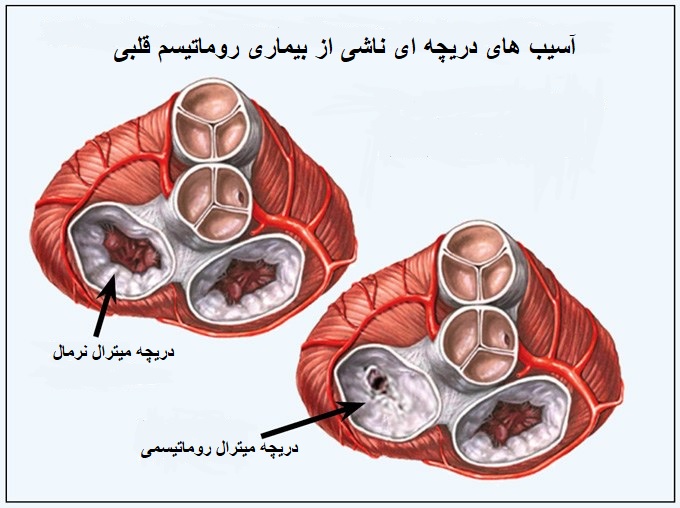
What role can technology play in addressing rheumatic fever?
Technological advancements offer new opportunities to combat rheumatic fever and its complications. Some potential applications include:
- Telemedicine platforms to improve access to specialist care in remote areas
- Mobile health applications for patient education and medication adherence
- Artificial intelligence-assisted diagnosis of strep throat and rheumatic fever
- Data analytics for improved surveillance and resource allocation
- Point-of-care diagnostic tools for rapid strep testing in resource-limited settings
By leveraging technology, healthcare providers and public health officials can enhance their ability to prevent, diagnose, and manage rheumatic fever, particularly in underserved populations.
5 Facts About Rheumatic Fever
Every year there are nearly 470,000 new cases of rheumatic fever across the globe. Approximately 305,000 people die every year from rheumatic heart disease, which rises from rheumatic fever. The U.S. and other developed countries have been able to provide access to medicine to prevent and treat rheumatic fever. However, many people living around the world don’t have access to the medicine they need. This leaves them and their children vulnerable to rheumatic fever and rheumatic heart disease. Here are five facts about rheumatic fever and how it affects communities across the globe.
5 Facts About Rheumatic Fever
- Poorly treated streptococcal infections can cause rheumatic fever. Streptococcal infections come from a bacteria called Group A Streptococcus (group A strep). These infections can cause strep throat, scarlet fever, streptococcal toxic shock syndrome and several other diseases. Doctors can easily treat strep throat or scarlet fever with simple antibiotics.
 Complications from rheumatic fever, however, are more difficult to treat. When the body starts to fight against itself after many strep infections, heart valves and other tissues can become scarred and inflamed. This is what rheumatic fever is. Antibiotics are not widely available in all parts of the world. In certain areas of Africa and Asia, there are no doctors to diagnose and treat strep throat and scarlet fever. Consequently, this is where rheumatic fever is most common.
Complications from rheumatic fever, however, are more difficult to treat. When the body starts to fight against itself after many strep infections, heart valves and other tissues can become scarred and inflamed. This is what rheumatic fever is. Antibiotics are not widely available in all parts of the world. In certain areas of Africa and Asia, there are no doctors to diagnose and treat strep throat and scarlet fever. Consequently, this is where rheumatic fever is most common. - Rheumatic fever can lead to rheumatic heart disease. Rheumatic heart disease happens when rheumatic fever leaves permanent scarring on the heart valves. This can narrow the valves or cause leaking in the valves. When the valves don’t work properly, the heart has a harder time pumping blood to the rest of the body. This eventually leads to heart failure and death. Rheumatic fever and rheumatic heart disease are fairly uncommon in developed countries like the U.S., but rheumatic fever is the number one source of heart disease in children and young adults in underdeveloped countries in Asia, sub-Saharan Africa and Latin America.

- Rheumatic fever and rheumatic heart disease plague indigenous Australian communities. These diseases disproportionately affect indigenous Australians, including communities of Torres Strait islanders and the Māori people. These communities report some of the highest numbers of cases in the entire world. In 2018, indigenous Australian communities reported 59 cases of rheumatic fever for every 100,000 people. Non-indigenous Australian communities reported less than one case for every 100,000 people. About 94% of rheumatic fever cases in Australia occur in indigenous communities. High rates can decrease through access to healthcare, reduced overcrowding and better living conditions.
- Most victims are children anywhere from five to 15 years old. As most strep infections affect children, rheumatic fever and rheumatic heart disease also primarily affect children. Children have naturally weaker immune systems because of their lack of exposure to different sicknesses, so strep infections that are easier for adults to fight off are more difficult for children to overcome.
 Repeated and untreated strep infections increase the risk of rheumatic fever occurring. Rheumatic heart disease is the most common type of heart disease in children.
Repeated and untreated strep infections increase the risk of rheumatic fever occurring. Rheumatic heart disease is the most common type of heart disease in children. - RHD Action is fighting back against rheumatic heart disease. The RHD Action movement is a united force of three organizations intent on ending rheumatic fever and thus rheumatic heart disease. The organizations that comprise RHD Action are the World Heart Federation, Reach and the Medtronic Foundation. Together, these groups have raised awareness about the importance of diagnosing and treating strep infections to prevent complications from arising. RHD Action’s efforts have reached refugee camps in Uganda and areas of Brazil, among many others. RHD Action provides resources for families of children that have rheumatic fever and rheumatic heart disease. It also educates those living in developed countries on the importance of access to medicine and quality care.
Looking Ahead
These five facts about rheumatic fever highlight that through widespread access to quality healthcare and overall better living conditions, communities can stop the spread. This will help save children the pain of replacing heart valves, blood clots, severe joint pain and other effects of rheumatic heart disease.
This will help save children the pain of replacing heart valves, blood clots, severe joint pain and other effects of rheumatic heart disease.
While doctors currently have no cure for rheumatic heart disease or the complications that come from rheumatic fever, the preventative treatments are plenty. Right now, there may be 470,000 new cases of rheumatic fever every year, but that can change with education, healthcare and access to a better quality of life.
– Holly Dorman
Photo: Flickr
Rheumatic fever – Symptoms and causes
Overview
Rheumatic fever is an inflammatory disease that can develop when strep throat or scarlet fever isn’t properly treated. Strep throat and scarlet fever are caused by an infection with streptococcus (strep-toe-KOK-us) bacteria.
Rheumatic fever most often affects children who are between 5 and 15 years old, though it can develop in younger children and adults. Although strep throat is common, rheumatic fever is rare in the United States and other developed countries.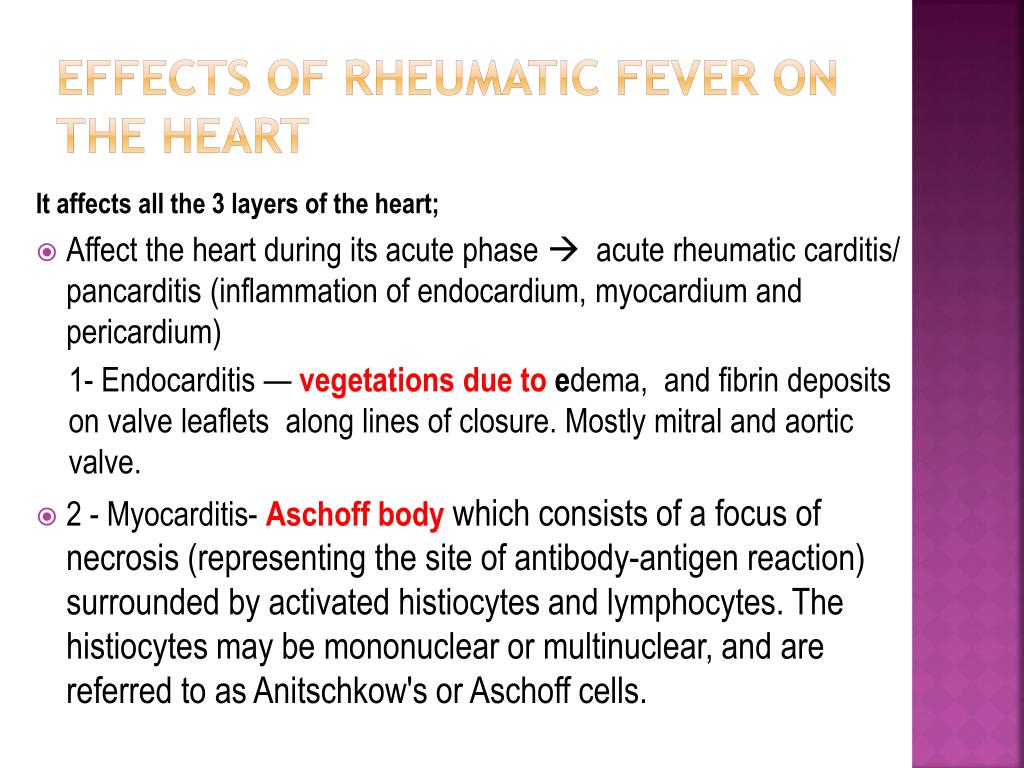 However, rheumatic fever remains common in many developing nations.
However, rheumatic fever remains common in many developing nations.
Rheumatic fever can cause permanent damage to the heart, including damaged heart valves and heart failure. Treatments can reduce damage from inflammation, lessen pain and other symptoms, and prevent the recurrence of rheumatic fever.
Symptoms
Rheumatic fever symptoms vary. You can have few symptoms or several, and symptoms can change during the course of the disease. The onset of rheumatic fever usually occurs about two to four weeks after a strep throat infection.
Rheumatic fever signs and symptoms — which result from inflammation in the heart, joints, skin or central nervous system — can include:
- Fever
- Painful and tender joints — most often in the knees, ankles, elbows and wrists
- Pain in one joint that migrates to another joint
- Red, hot or swollen joints
- Small, painless bumps beneath the skin
- Chest pain
- Heart murmur
- Fatigue
- Flat or slightly raised, painless rash with a ragged edge
- Jerky, uncontrollable body movements (Sydenham chorea) — most often in the hands, feet and face
- Outbursts of unusual behavior, such as crying or inappropriate laughing, that accompanies Sydenham chorea
When to see a doctor
Have your child see a doctor for signs or symptoms of strep throat, which include:
- Sore throat that comes on suddenly
- Pain when swallowing
- Fever
- Headache
- Stomach pain, nausea and vomiting
Proper treatment of strep throat can prevent rheumatic fever. Also, have your child see a doctor if he or she shows other indications of rheumatic fever.
Also, have your child see a doctor if he or she shows other indications of rheumatic fever.
Causes
Rheumatic fever can occur after a throat infection from a bacteria called group A streptococcus. Group A streptococcus infections of the throat cause strep throat or, less commonly, scarlet fever.
Group A streptococcus infections of the skin or other parts of the body rarely trigger rheumatic fever.
The link between strep infection and rheumatic fever isn’t clear, but it appears that the bacteria trick the immune system.
The strep bacteria contain a protein similar to one found in certain tissues of the body. The body’s immune system, which normally targets infection-causing bacteria, attacks its own tissue, particularly tissues of the heart, joints, skin and central nervous system. This immune system reaction results in swelling of the tissues (inflammation).
If your child receives prompt treatment with an antibiotic to eliminate strep bacteria and takes all medication as prescribed, there’s little chance of developing rheumatic fever.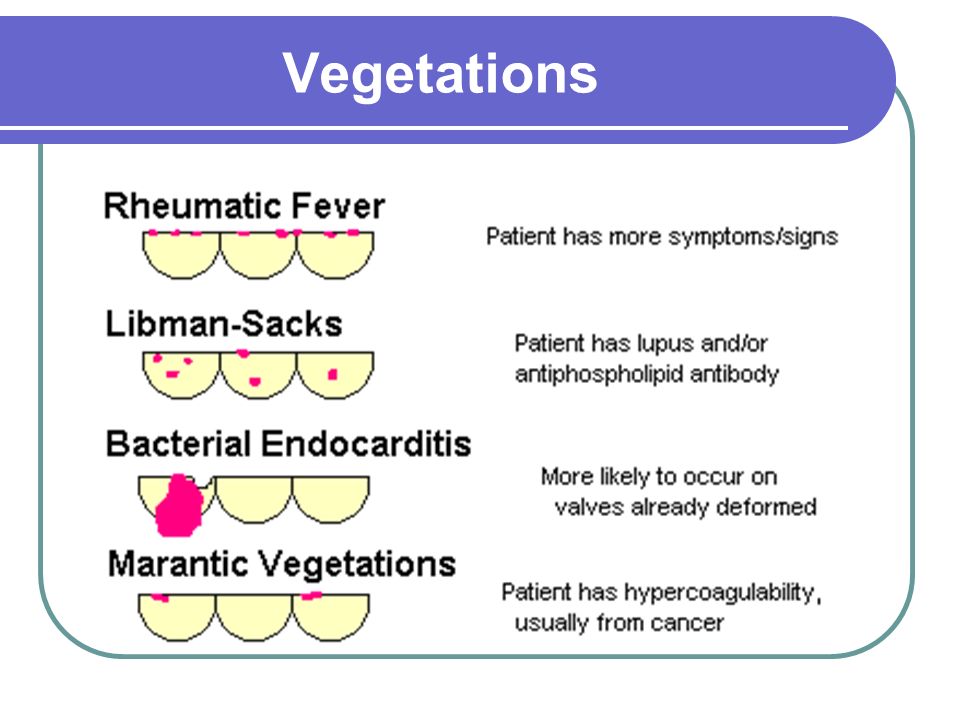
If your child has one or more episodes of strep throat or scarlet fever that aren’t treated or aren’t treated completely, he or she might develop rheumatic fever.
Risk factors
Factors that can increase the risk of rheumatic fever include:
- Family history. Some people carry a gene or genes that might make them more likely to develop rheumatic fever.
- Type of strep bacteria. Certain strains of strep bacteria are more likely to contribute to rheumatic fever than are other strains.
- Environmental factors. A greater risk of rheumatic fever is associated with overcrowding, poor sanitation and other conditions that can easily result in the rapid transmission or multiple exposures to strep bacteria.
Complications
Inflammation caused by rheumatic fever can last a few weeks to several months. In some cases, the inflammation causes long-term complications.
Rheumatic fever can cause permanent damage to the heart (rheumatic heart disease). It usually occurs 10 to 20 years after the original illness, but severe cases of rheumatic fever can cause damage to the heart valves while your child still has symptoms. Problems are most common with the valve between the two left chambers of the heart (mitral valve), but the other valves can be affected.
The damage can result in:
- Narrowing of the valve. This decreases blood flow.
- Leak in the valve. A leaky valve causes blood to flow in the wrong direction.
- Damage to heart muscle. The inflammation associated with rheumatic fever can weaken the heart muscle, affecting its ability to pump.
Damage to the mitral valve, other heart valves or other heart tissues can cause problems with the heart later in life. Resulting conditions can include:
- An irregular and chaotic heartbeat (atrial fibrillation)
- Heart failure
Prevention
The only way to prevent rheumatic fever is to treat strep throat infections or scarlet fever promptly with a full course of appropriate antibiotics.
Oct. 10, 2019
Rheumatic Fever & Heart Valve Disease: 8 Important Facts
Many patients in our community have had questions about the link between Rheumatic Fever (RF) and Heart Valve Disease. The patients, their families and friends want to know the answers to questions such as, “What causes RF?”, “Is it common?”, “How does it cause heart valve disease?” and “What can I do to prevent it?”
What Is Rheumatic Fever?
Rheumatic Fever (RF) is an inflammatory disease that can develop as a result of inadequately treated strep throat (and in rare cases, scarlet fever). Strep throat is caused by an infection of streptococcus bacteria, and as you probably already know, strep is common and easily treatable with penicillin.
If left untreated, however, strep bacteria can develop into Rheumatic Fever.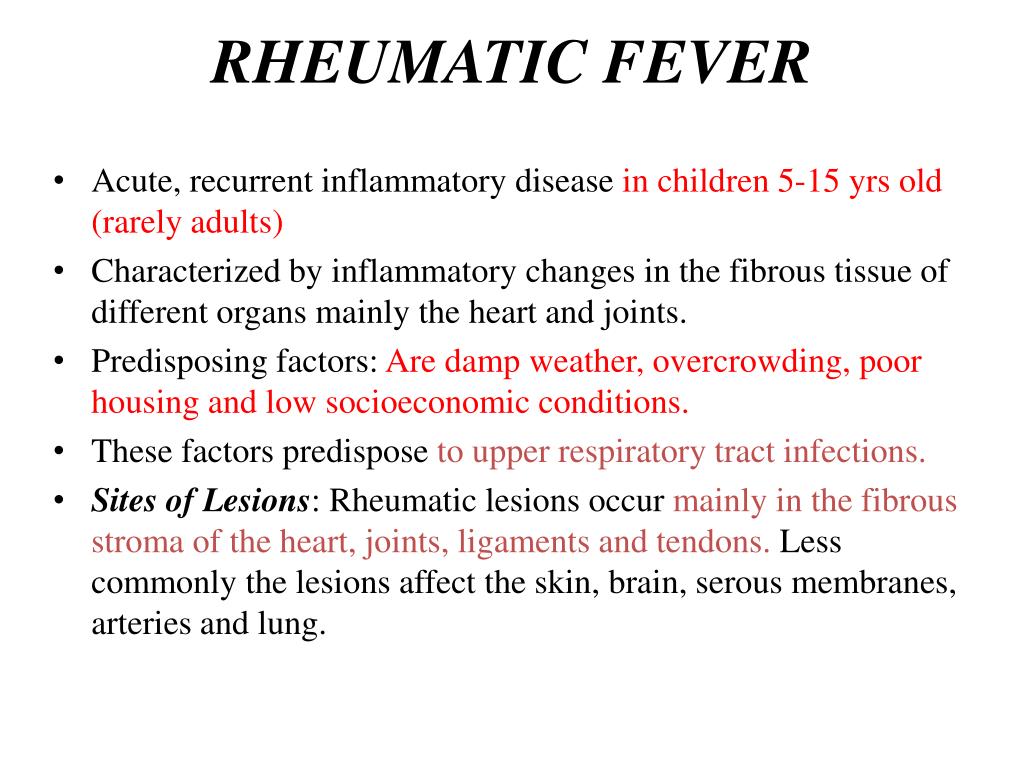 Our immune system’s response to RF causes an inflammatory condition in the body which can result in ongoing, chronic and permanent heart valve damage known as Rheumatic Heart Disease (RHD). If a lack of medical attention continues, RHD can further damage your heart and even lead to heart failure. All of that from strep throat? Well, yes, but there is a lot more to it.
Our immune system’s response to RF causes an inflammatory condition in the body which can result in ongoing, chronic and permanent heart valve damage known as Rheumatic Heart Disease (RHD). If a lack of medical attention continues, RHD can further damage your heart and even lead to heart failure. All of that from strep throat? Well, yes, but there is a lot more to it.
Who Is At Risk?
According to the Texas Heart Institute, fewer than 0.3% of people who have strep throat will also get RF, so it’s rare. According to the Cleveland Clinic, RF can occur at any age, yet Rheumatic Fever is most common among children and adolescents aged 5 to 15.
Also per the Texas Heart Institute, doctors think that a weakened immune system may make some people more likely to get RF. And, although antibiotic medicines have reduced the number of cases of RF, there are still thousands of reported cases in the U.S. and other developed nations. RF, however, remains far more common in many developing nations where there may be unsanitary conditions or a lack of medical treatment.
According to the Mayo Clinic, if a child receives prompt treatment with an antibiotic to eliminate strep and takes all medication as prescribed, there’s little chance of developing Rheumatic Fever. According to Johns Hopkins Medicine, children who get repeated strep throat infections that aren’t treated – or not treated completely – are at the most risk for RF.
RHD affects around half of all people who have had an acute RF, according to Very Well Health. According to the Mayo Clinic, most cases are diagnosed 10 to 20 years after contracting RF, and those who have had multiple bouts of RF are at greatest risk.
What Are The Causes?
Rheumatic Fever is not an infection itself, but rather your body’s response as a result of an untreated strep infection. According to the Mayo Clinic, the link between a strep infection and RF isn’t exactly clear, but it appears that the bacteria “tricks” the immune system. This is because the strep bacteria contains a protein similar to one found in certain tissues of the body.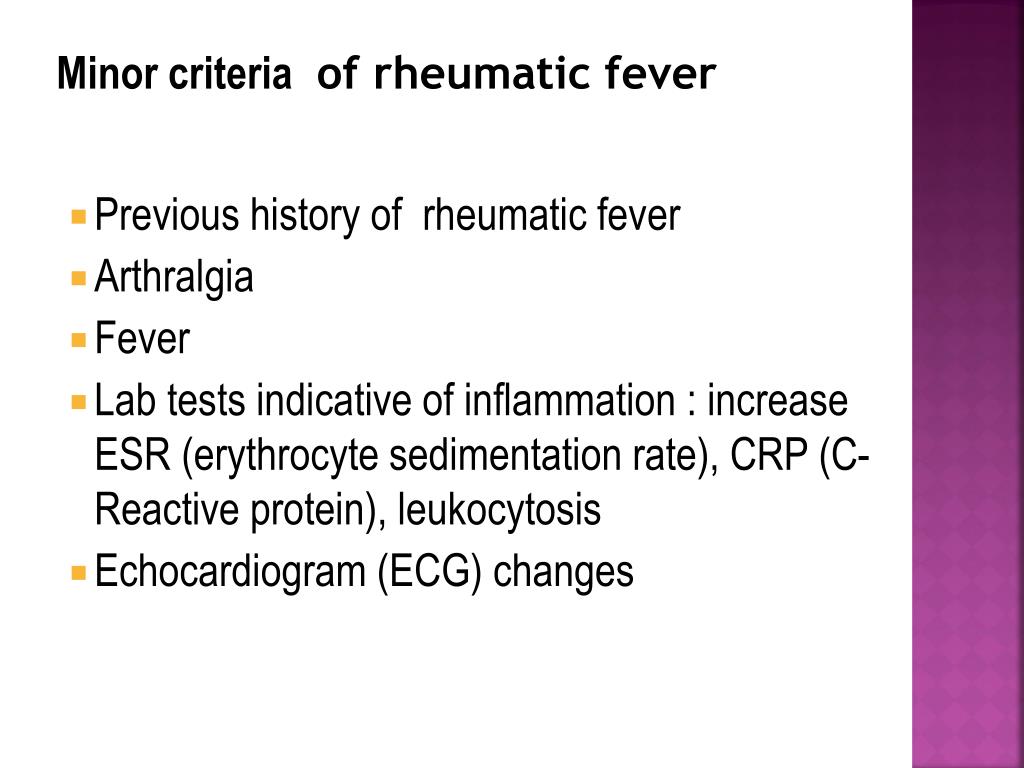
When your body senses the lingering strep infection, immune system cells that would normally target the bacteria sends antibodies to fight the infection, and the antibodies attack the body’s own tissues of your heart, joints, skin and central nervous system instead. This immune system reaction can trigger inflammation of the heart, either on the surface of the heart (pericarditis), within the heart (endocarditis), or the heart muscle itself (myocarditis). This can last a few weeks to several months and, in some cases – according to the Cleveland Clinic – can cause eventual scarring and other long-term complications.
What Are The Symptoms?
According to the Texas Heart Institute, symptoms of RF usually begin 1 to 6 weeks after a strep throat infection. RF signs and symptoms include:
- Fever
- Joint pain or swelling in your wrists, elbows, knees, or ankles
- Small bumps under the skin over your elbows or knees (called nodules)
- A raised, red rash on your chest, back, or stomach
- Stomach pain or feeling less hungry
- Fatigue, weakness, shortness of breath
Remember, RHD usually occurs 10 to 20 years after the original occurrence of RF per the Mayo Clinic, and – depending on the degree of valve damage – may include RHD symptoms such as:
- Chest pain and discomfort
- Heart murmur
- Jerky, uncontrollable body movements – most often in the hands, feet and face
What Are The Complications?
According to the Mayo Clinic, untreated Rheumatic Fever can cause permanent damage to the heart valves and even lead to heart failure.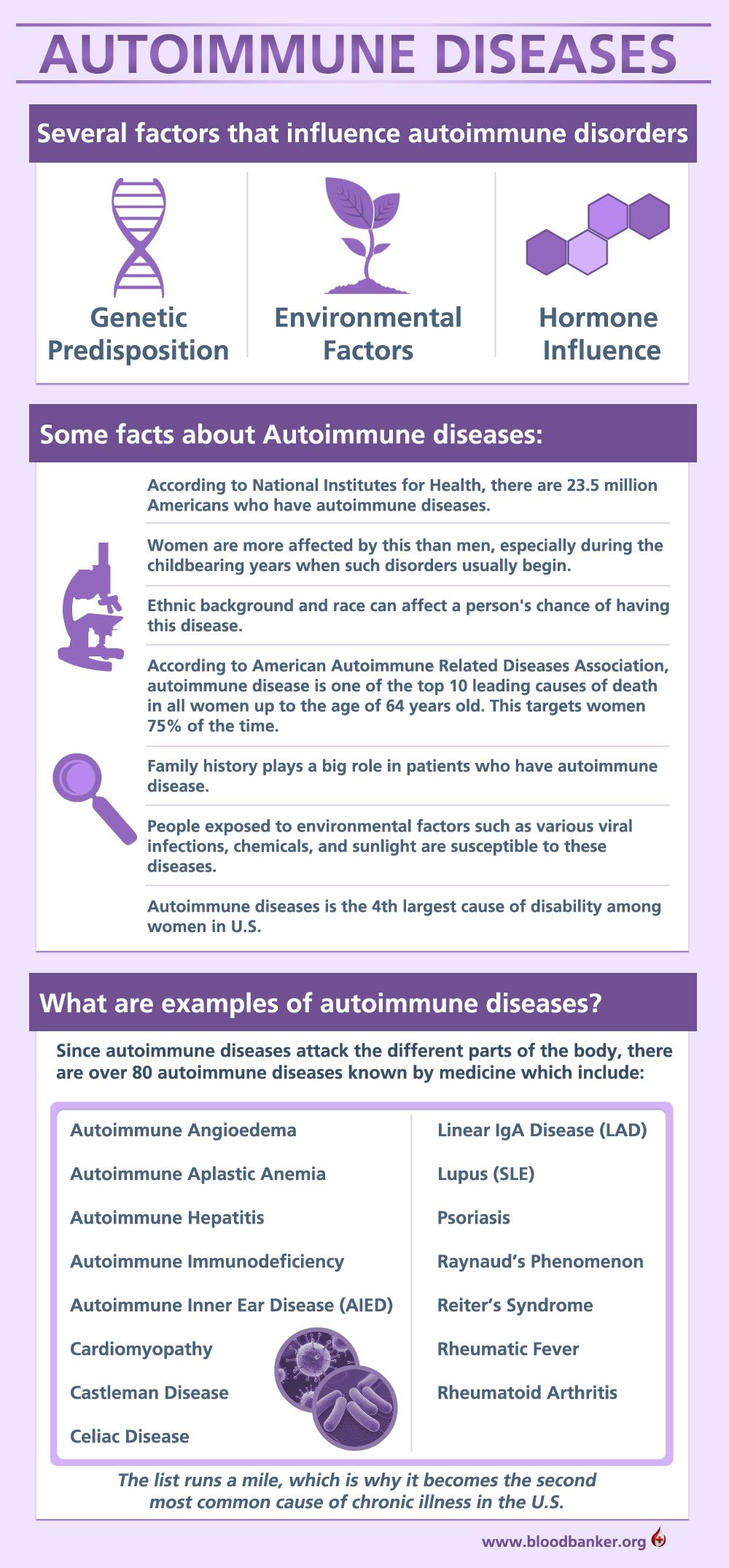
More than half of the time, RF leads to scarring of the heart’s valves. Per the Cleveland Clinic, scarring can narrow the valve – most commonly the mitral valve – and make it harder for the valve to open or close properly. Mitral Stenosis causing your heart to work harder to pump blood normally. This valve damage can lead to RHD. Rheumatic Heart Disease is permanent damage to the heart caused by Rheumatic Fever. Problems are most common with the mitral valve, but the other valves can be affected.
According to the Mayo Clinic, the result can be:
- Valve stenosis. Narrowing of the valve decreases blood flow.
- Valve regurgitation. Leaking in the valve allows blood to flow in the wrong direction.
- Damage to heart muscle. Weakening of the heart muscle, affecting its ability to pump.
- Damage to the mitral valve, which can cause problems with the heart later in life such as atrial fibrillation (an irregular and chaotic beating of the upper chambers of the heart) and heart failure (an inability of the heart to pump enough blood to the body).

As Johns Hopkins Medicine suggests, other complications of RHD include:
- Bacterial endocarditis. An infection of the inner lining of the heart, and may occur when RF has damaged the heart valves.
- Complications of pregnancy and delivery. Women with RHD should discuss their condition with their doctor before getting pregnant.
- Ruptured heart valve. This is a medical emergency that must be treated with surgery to replace or repair the heart valve.
How Are RF & RHD Diagnosed?
According to the Texas Heart Institute, your doctor will begin by doing a throat culture to find out if you have a strep infection. Then, your doctor will use a stethoscope to listen to your heart. He or she will also look for nodules on your joints. Sometimes, blood tests, chest x-rays, or an electrocardiogram (ECG or EKG) may be needed for a more definite diagnosis.
RHD is diagnosed – per Johns Hopkins Medicine – by evaluating you to hear if you have a murmur or rub that may be heard during a routine physical exam. The murmur is caused by the blood leaking around the damages valve. The rub is caused when the inflamed heart tissues move or rub against each other.
The murmur is caused by the blood leaking around the damages valve. The rub is caused when the inflamed heart tissues move or rub against each other.
Along with a complete medical history and physical exam, tests used to diagnose RHD may include:
- Echocardiogram (echo). Shows damage to the valve flaps, backflow of blood through a leaky valve, fluid around the heart, and heart enlargement.
- Electrocardiogram (ECG). Shows abnormal rhythms (arrhythmias or dysrhythmias) and can sometimes detect heart muscle damage.
- Chest X-ray. Checks your lungs and see if your heart is enlarged.
- Cardiac MRI. Gets a more precise look at the heart valves and heart muscle.
- Blood test. Looks for infection and inflammation.
Can Rheumatic Fever Be Prevented?
Remember, RF is most often the result of inadequate treatment of strep throat. The only way to prevent RF is to treat strep throat infections promptly with a full course of antibiotics such as penicillin.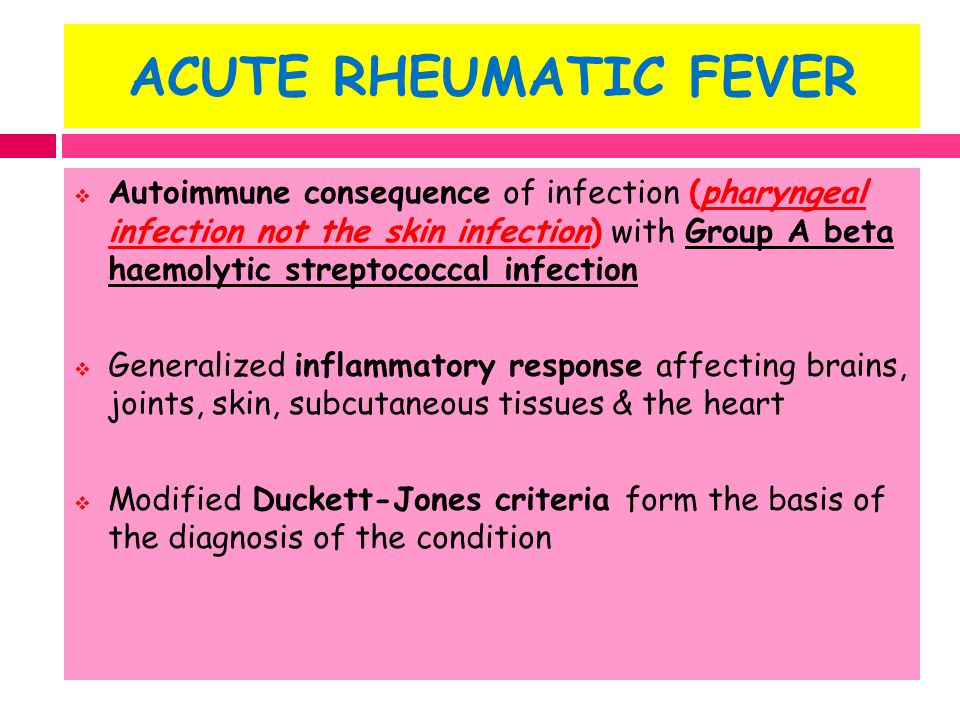 If you have strep throat, take all of the antibiotics your doctor prescribes, even if you feel better before the medicine is gone.
If you have strep throat, take all of the antibiotics your doctor prescribes, even if you feel better before the medicine is gone.
According to the Texas Heart Institute, even if your sore throat does not come back, without the antibiotics in your bloodstream, the streptococcal bacteria can still multiply and affect your heart.
Also you should always tell your doctor or dentist about your history of RF before a surgical or dental procedure.
What Is The Treatment?
According to Texas Heart Institute, RF must be treated right away. If you have a sore throat that lasts longer than 2 days, or if you have a fever and headache with your sore throat, you should see your doctor for a throat culture. Even if you do not have a sore throat but have a fever and a skin rash, this could also mean strep.
If your strep infection leads to RF, your doctor may prescribe anti-inflammatory medicines to reduce the swelling in your body’s tissues. How long you take them depends on your age, the number of attacks you’ve had, and the severity of your symptoms.
How long you take them depends on your age, the number of attacks you’ve had, and the severity of your symptoms.
According to Johns Hopkins Medicine, people who have had acute RF are often given daily or monthly antibiotic treatments, possibly for life, to prevent recurrent infections and lower the risk of further heart damage. To reduce inflammation, aspirin, steroids, or non-steroidal medicines may be given. If you have had RF, it is important to prevent future episodes. If you have had acute RF, undergo an annual physical exam to check for a possible heart murmur or any other heart abnormality.
If RF has led to RHD or damage to your heart valves, your doctor may recommend that you take antibiotic medicines continuously for many years.
If you are diagnosed with RHD, it is important to have your condition monitored regularly with an echocardiogram and other diagnostic tools. As heart valve problems tend to worsen over time, these exams can help determine if and when valve replacement surgery is needed to replace or repair a badly damaged valve.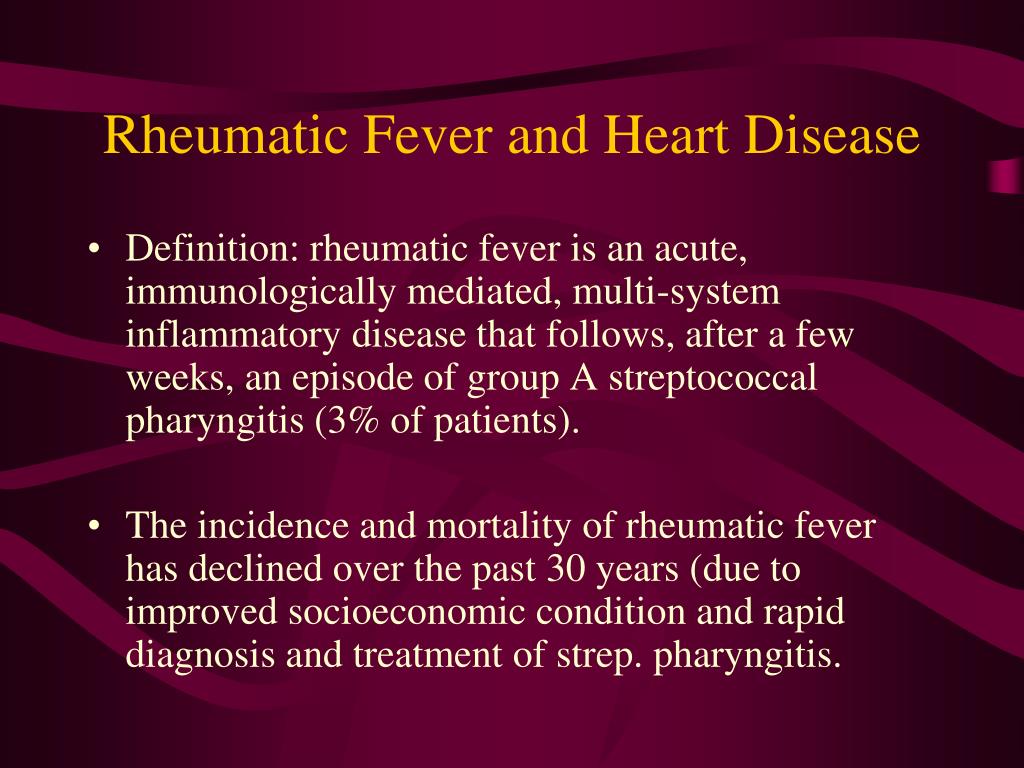
So the bottom line is that minor infections – such as strep – can lead to a far worse diagnosis if left untreated. I hope that answered your questions about Rheumatic Fever and the link to Heart Valve Disease.
You May Also Like
Page last updated: September 18, 2020
References:
Cleveland Clinic. https://my.clevelandclinic.org/health/diseases/17600-valve-disease-types
Very Well Health. https://www.verywellhealth.com/rheumatic-heart-disease-1746054
National Heart, Lung, and Blood Institute. https://www.nhlbi.nih.gov/health-topics/heart-valve-disease
Mayo Clinic https://www.mayoclinic.org/diseases-conditions/rheumatic-fever/symptoms-causes/syc-20354588
Johns Hopkins Medicine. https://www.hopkinsmedicine.org/healthlibrary/conditions/cardiovascular_diseases/
rheumatic_heart_disease_85,P00239
Texas Heart Institute. https://www.texasheart.org/heart-health/heart-information-center/topics/rheumatic-fever/
Rheumatic fever | pathology | Britannica
Rheumatic fever, inflammatory disease of the heart, joints, central nervous system, and subcutaneous tissues that develops after a throat infection with group A beta-hemolytic Streptococcus bacteria, including untreated scarlet fever or strep throat.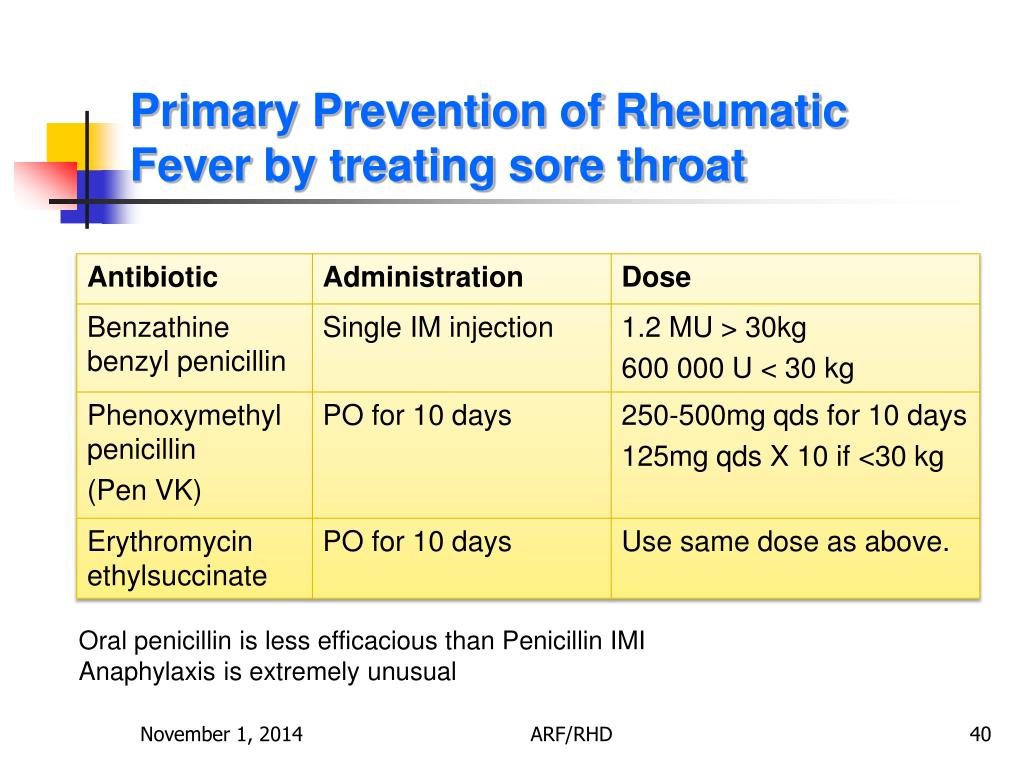 Prevention is possible with penicillin, but specific treatment is not available. Rheumatic fever is particularly important because of the heart disease, which includes vascular damage, that may ensue. The illness occurs chiefly in children and young adults, with a peak incidence between ages 5 and 15.
Prevention is possible with penicillin, but specific treatment is not available. Rheumatic fever is particularly important because of the heart disease, which includes vascular damage, that may ensue. The illness occurs chiefly in children and young adults, with a peak incidence between ages 5 and 15.
When a streptococcal throat infection goes untreated, most patients recover without complications. Approximately 1 percent, however, develop rheumatic fever. The onset of the disease is most often characterized by the sudden occurrence of fever and joint pain and inflammation several days to six weeks after the streptococcal infection. Signs of cardiac involvement include heart murmurs, increased heartbeat rate, and heart enlargement. Inflammation of the heart muscle and supporting structures may lead to a permanent scarring and contracture of the heart valves and a marked decrease in life expectancy. Other symptoms of rheumatic fever include nodules beneath the skin and skin rashes, the most typical of which is erythema marginatum; Sydenham chorea, a nervous system manifestation marked by emotional instability and purposeless, involuntary movements of the arms and legs; abdominal pain; nosebleeds; weakness; and loss of appetite and body weight. Generally the clinical symptoms, severity, and aftereffects of an attack of rheumatic fever are highly variable, ranging from a condition so mild as to go unnoticed to a severe acute attack associated with cardiac failure and death.
Generally the clinical symptoms, severity, and aftereffects of an attack of rheumatic fever are highly variable, ranging from a condition so mild as to go unnoticed to a severe acute attack associated with cardiac failure and death.
Britannica Quiz
Diseases, Disorders, and More: A Medical Quiz
What condition is caused by the deposition of salts of uric acid? What’s another name for breakbone fever? Find out what you know about diseases, disorders, and more.
During the course of rheumatic fever, the streptococcal organism may no longer be demonstrable in cultures of the throat or other infected body areas, but blood titres of antibodies against the streptococcus, such as antistreptolysin O, are high. All the numerous types of group A beta-hemolytic Streptococcus appear capable of inducing rheumatic fever in susceptible individuals; infection with one type confers no immunity against the others, and individuals who have experienced one attack of rheumatic fever are especially prone to subsequent attacks. Both the initial and recurrent attacks can be effectively prevented with penicillin. Symptomatic treatment of the condition includes the use of salicylates such as aspirin or one of the steroid hormones. Surgery may be advocated to relieve the narrowing of the openings of the heart valves. Rheumatic fever patients must receive antibiotics on a regular basis for the remainder of their lives because their damaged heart valves predispose them to the development of bacterial endocarditis.
Both the initial and recurrent attacks can be effectively prevented with penicillin. Symptomatic treatment of the condition includes the use of salicylates such as aspirin or one of the steroid hormones. Surgery may be advocated to relieve the narrowing of the openings of the heart valves. Rheumatic fever patients must receive antibiotics on a regular basis for the remainder of their lives because their damaged heart valves predispose them to the development of bacterial endocarditis.
The exact cause of rheumatic fever is not clear, although most authorities favour the theory that the disease results from an autoimmune reaction, involving the production of antibodies that attack the body’s own tissues. The autoimmune reaction is believed to be triggered by components of the streptococci (antigens) whose structure resembles that of molecules found in human tissue (“self antigens”). Because of this resemblance, the antibodies that recognize streptococcal antigens may mistakenly react with similarly shaped antigens of certain cells of the body—such as those of the heart. By binding to these self antigens, the antibodies cause the tissue damage characteristic of rheumatic fever.
By binding to these self antigens, the antibodies cause the tissue damage characteristic of rheumatic fever.
Get a Britannica Premium subscription and gain access to exclusive content.
Subscribe Now
Since the mid-20th century the incidence and severity of rheumatic fever and other streptococcal infections, such as scarlet fever, have declined precipitously in the developed countries. This decline has occurred independently of the use of penicillin and other drugs and may simply signal the gradual dying out of the disease. However, in many other parts of the world rheumatic fever remains a serious and prevalent disease.
Rheumatic Heart disease fact sheet
Acute Rheumatic Fever
Acute rheumatic fever is an illness that can happen after an infection with a germ called group A Streptococcus.
Group A streptococcus causes sore throats and skin sores.
Acute rheumatic fever is more likely to affect:
- children aged 5-14
- someone who has had acute rheumatic fever before
- Aboriginal and Torres Strait Islander people
- Maori and Pacific Islander people.

Acute rheumatic fever can affect
The brain causing abnormal body movements or twitches
The body causing fever
The joints causing sore and swollen joints
The skin causing rashes and lumps
The heart causing weakness, shortness of breath, tiredness, chest pain or a rapid heart beat
How is it prevented?
Visit your doctor or clinic:
- if you have a sore throat, or
- if you have one or more symptoms of acute rheumatic fever.
Rheumatic heart disease
Acute rheumatic fever can cause damage to the heart valves. This is called rheumatic heart disease or RHD.
This damage to the heart valves makes it hard for your heart to work properly.
Having acute rheumatic fever more than once can make your heart damage worse.
How is it diagnosed?
Your doctor might:
- ask you about your symptoms
- check your body for signs of these conditions
- take a throat swab
- do some blood tests
- take a chest x-ray
- do tests to check how your heart is working (such as an echocardiogram or ECG).

How is it treated?
People who have acute rheumatic fever or rheumatic heart disease need antibiotic injections every 4 weeks to prevent new attacks.
You should also:
- have regular check-ups with your doctor
- have regular check-ups with your heart specialist
- have regular check-ups with your dentist
- get a vaccination for pneumococcal disease and yearly vaccinations for the flu.
People with severe rheumatic heart disease may require surgery.
More information
More information about RHD is available in the “Things you need to know” booklet available on the Rheumatic Heart Disease Australia website.
You can also talk with your doctor, nurse, Aboriginal health worker, or call your local public health unit on 1300 066 055.
Rheumatic Fever – Causes, Symptoms, Treatment, Diagnosis
The Facts
Rheumatic fever is an inflammatory disease that can happen after a person becomes infected with the Streptococcus bacteria.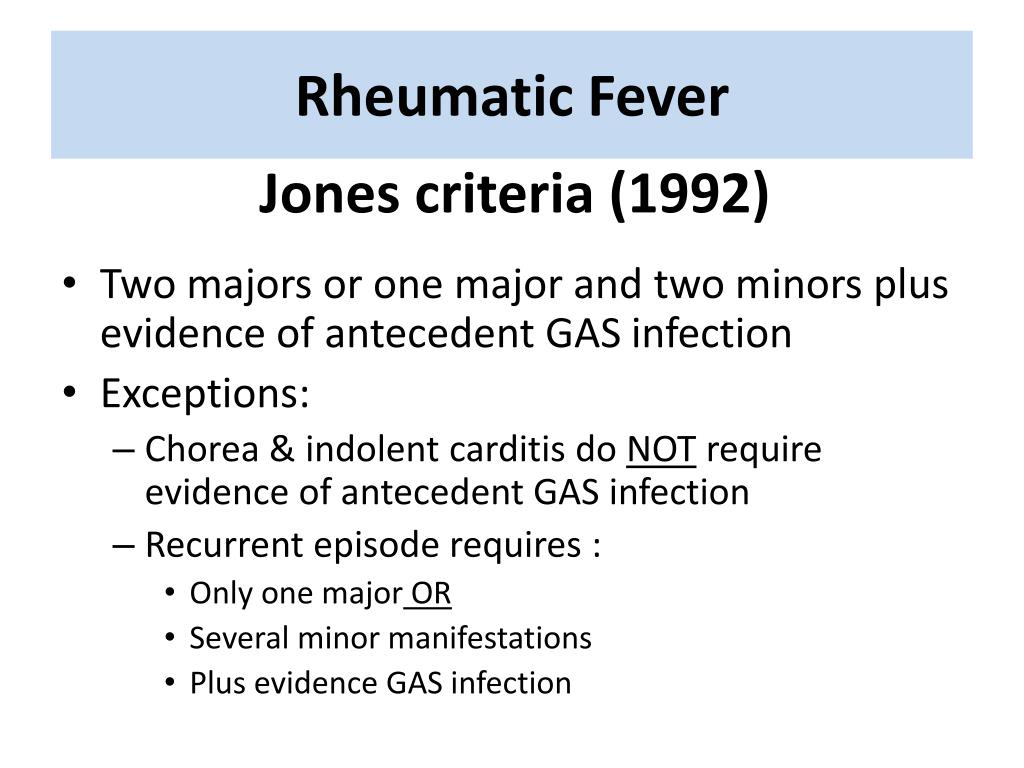
Rheumatic fever was once a common cause of heart problems in childhood. It remains a serious childhood health problem in many developing countries. In North America, it’s become much less common due to improved hygiene and routine use of antibiotics for infections. When it does strike, however, it can still have serious consequences for heart health.
Rheumatic fever is most frequent in children aged 5 to 15 years old, but can also affect adults and children younger than 5 years of age. However, there are no reliable figures on adults.
Causes
Rheumatic fever is caused by a combination of bacterial infection and immune system overreaction. It almost always follows a strep throat infection, which is an infection of the respiratory tract caused by bacteria of the Streptococcus family. Children are far more likely to get strep throat than adults.
Normally, Streptococcus causes a cough and a sore throat, and clears up with antibiotics. In some cases, however, children with strep throat begin complaining of pain in the joints or other unusual symptoms. This usually happens 2 to 4 weeks after the streptococcal infection (which may have already cleared up).
In some cases, however, children with strep throat begin complaining of pain in the joints or other unusual symptoms. This usually happens 2 to 4 weeks after the streptococcal infection (which may have already cleared up).
The disease has an affinity for the joints, the central nervous system (brain and spinal cord), and the heart. In the heart, the disease can affect the inner lining of the heart including the heart valves (endocarditis), the muscle of the heart (myocarditis), or the covering of the heart (pericarditis).
In some people, the body reacts with a massive immune system reaction to the affected areas. The cells that normally kill invading bacteria become so active that they also attack the affected tissues. The result in the joints is temporary arthritis (inflammation of the joints). In the heart, they can permanently damage heart valves, increasing the risk of heart problems later in life. Rheumatic fever can also cause problems with the nervous system that are usually reversible.
Symptoms and Complications
The symptoms of rheumatic fever depend on whether the heart, joints, or nervous system are affected. Most people with rheumatic fever have fever and joint pain. The joint pain (arthritis) usually affects large joints such as the knees, elbows, ankles, or wrists. The joint pain characteristically migrates from one joint to another, so that one or more joints may be swollen, red, and extremely tender. The joint pain is usually reversible.
Many people who develop rheumatic fever suffer damage to the tissues of the heart, which may include their heart valves (endocarditis), heart muscle (myocarditis), sac covering the heart (pericarditis), or all three. This may cause no symptoms, but some people feel heart palpitations or chest pain. Occasionally, there is heart failure, though few people in North America die during a rheumatic fever episode.
In severe cases, the valves ultimately have to be replaced with artificial ones.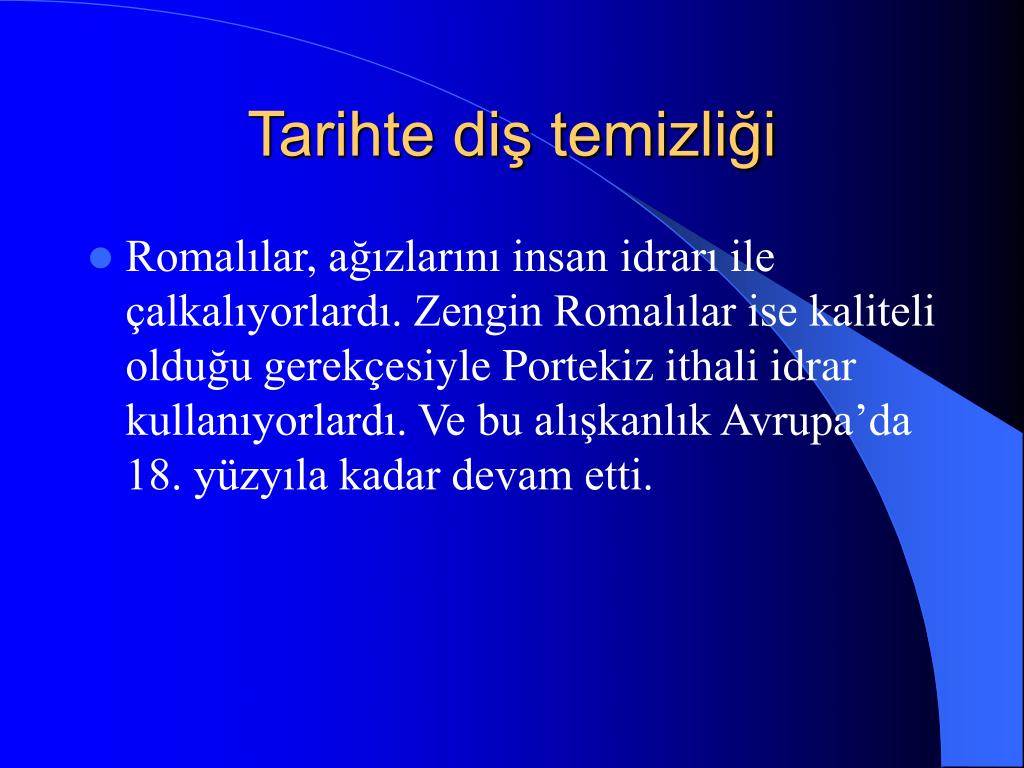 People with damaged valves and those with an artificial heart valve are at increased risk of a heart infection later in life (infectious endocarditis).
People with damaged valves and those with an artificial heart valve are at increased risk of a heart infection later in life (infectious endocarditis).
The central nervous system may also be affected to produce a symptom known as chorea. Chorea affects females more frequently and almost never occurs after puberty. The onset of chorea is usually gradual, and it often first appears several months after the rheumatic fever has passed. Occasionally, chorea is the only visible symptom of rheumatic fever. Teachers may be the first to notice it and mistake it for clumsiness or restlessness. Symptoms of chorea may include:
- grimacing
- muscular weakness
- involuntary, purposeless movements of the arms and legs
- emotional disturbances (crying and restlessness)
Rheumatic fever can also cause skin lesions to develop. These can be firm and painless nodules under the skin that can be present for one or more weeks, or non-itching rashes (called erythema marginatum) that usually affect the trunk of the body and appear and disappear within hours.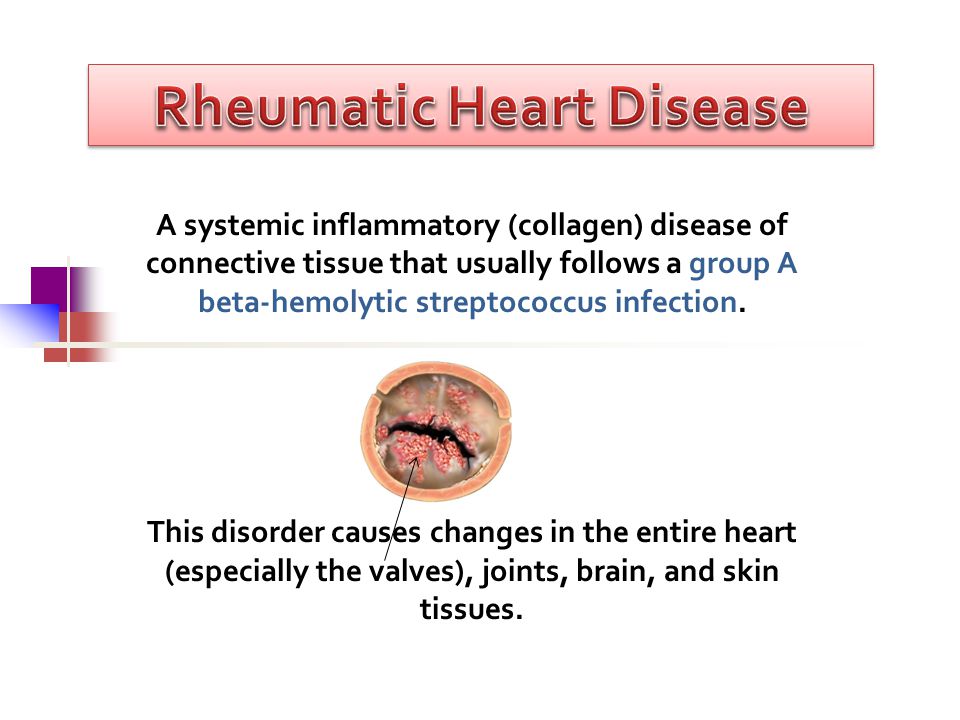
Making the Diagnosis
The actual quantity of bacteria in the systems of people with rheumatic fever is often so low that the bacteria are undetectable. Doctors rely on a standardized checklist to identify the disease.
If you have a recent history of streptococcal infection, and at least 2 symptoms from a list of 5 common symptoms: arthritis, chorea, erythema marginatum, nodules under the skin, and carditis, your doctor may diagnose you with rheumatic fever.
Your doctor will listen to your heart with a stethoscope to help detect carditis. The diagnosis can also be made with only one of these common symptoms if other abnormalities are present at the same time. These include: sore joints, fever, rheumatic fever in the past, a specific abnormality on electrocardiogram (ECG; prolonged PR interval), or specific abnormalities on blood testing (elevated C-reactive protein or sedimentation rate).
Certain tests can also support the diagnosis by detecting antibodies the body produce against the Streptococcus bacteria, or by detecting the bacteria itself.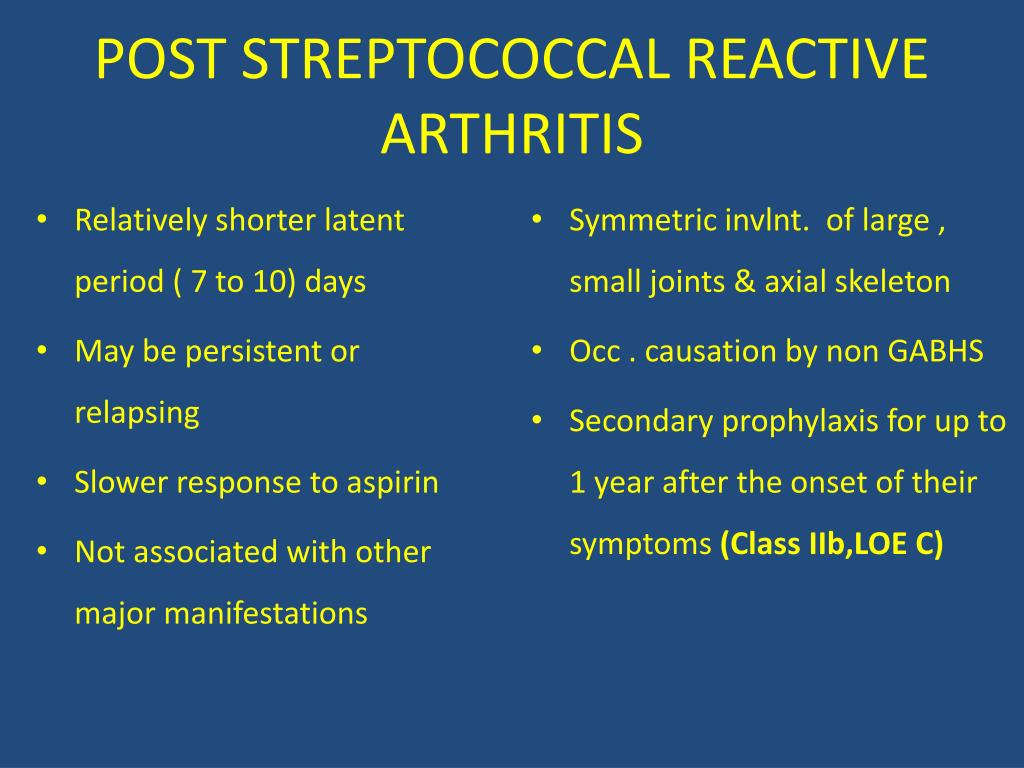
Before making any treatment decisions, your doctor will want to rule out other conditions that can affect the heart. Tests like the echocardiogram (ultrasound of the heart) can reveal the presence of congenital heart defects that might be confused with rheumatic fever.
Treatment and Prevention
The best way to prevent rheumatic fever is to have strep throat treated promptly with penicillin* or other antibiotics. The strep infection should be confirmed with a throat swab before treatment is started, and rheumatic fever will be prevented as long as treatment is started within 5 or 6 days. Therefore, there is time to safely wait for the swab result. The main reason to treat strep throat is to prevent rheumatic fever. Pain killers, hot drinks, and gargling would also help the sore throat, but only the antibiotics can kill the bacteria and make the symptoms disappear.
Although bacteria are responsible for triggering rheumatic fever, antibiotics can do little to help once you have rheumatic fever, and treatment then aims at relieving symptoms.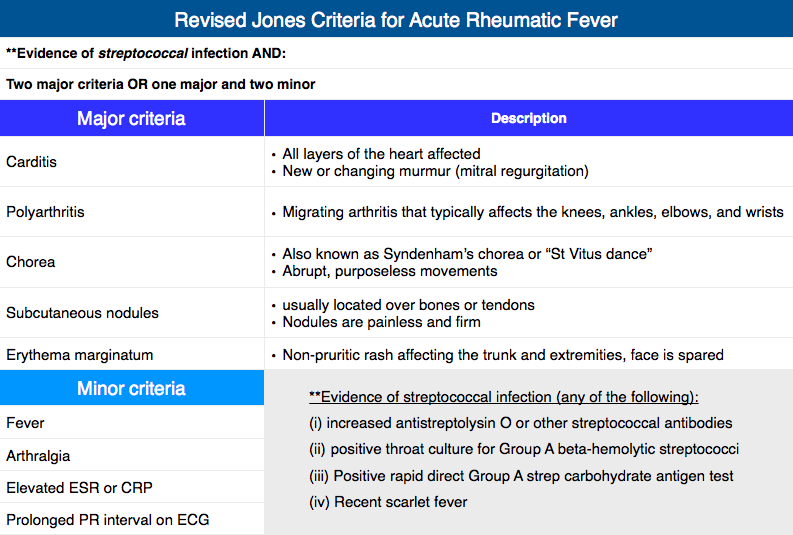 The normal treatment for joint inflammation and pain in rheumatic fever is the use of nonsteroidal anti-inflammatory drugs (NSAIDs).
The normal treatment for joint inflammation and pain in rheumatic fever is the use of nonsteroidal anti-inflammatory drugs (NSAIDs).
Because people who’ve had rheumatic fever are more prone to further attacks if they get another strep infection, they may be given monthly intramuscular penicillin or daily penicillin treatment by mouth, perhaps for life. If their heart has been damaged by rheumatic fever, they’re also given a different antibiotic when they undergo any dental or surgical procedures to reduce the risk of bacterial heart valve infection (endocarditis).
There’s no treatment that will make chorea go away more quickly, though children with chorea are often given antibiotics to prevent endocarditis. Fortunately, the symptoms of chorea often disappear within a few months, although sometimes they may take a year or more to go away.
The rash and the nodules usually clear up on their own.
All material copyright MediResource Inc. 1996 – 2021. Terms and conditions of use.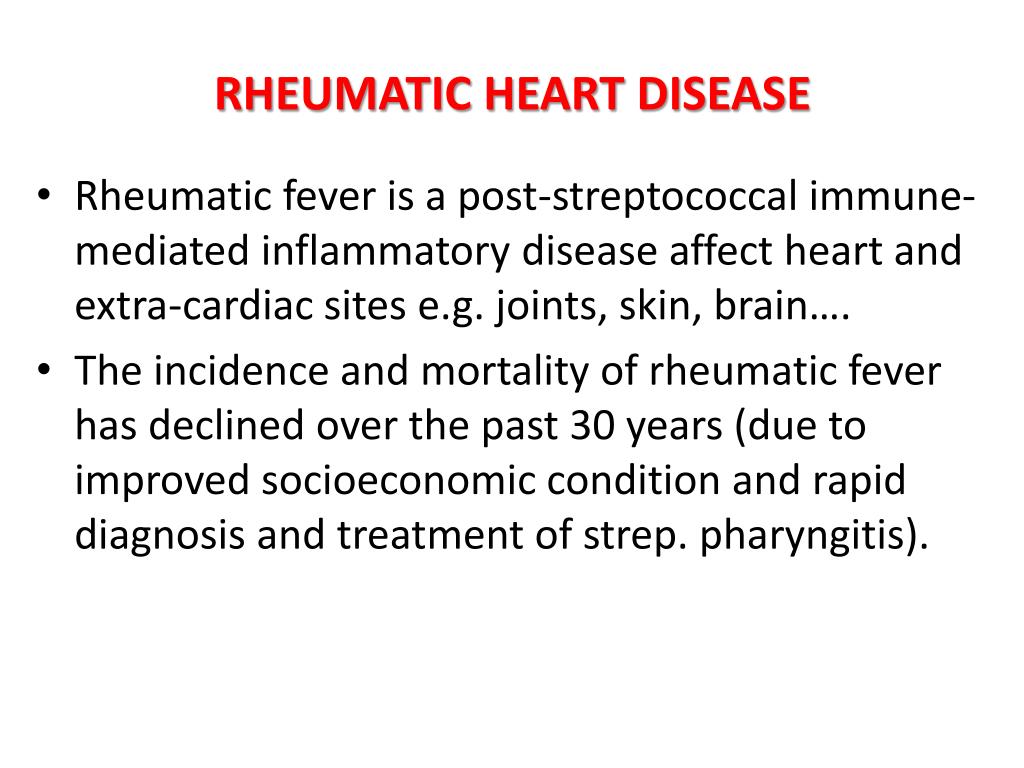 The contents herein are for informational purposes only. Always seek the advice of your physician or other qualified health provider with any questions you may have regarding a medical condition. Source: www.medbroadcast.com/condition/getcondition/Rheumatic-Fever
The contents herein are for informational purposes only. Always seek the advice of your physician or other qualified health provider with any questions you may have regarding a medical condition. Source: www.medbroadcast.com/condition/getcondition/Rheumatic-Fever
Rash, Symptoms, Treatment, What Is It
Overview
What is rheumatic fever?
Rheumatic fever is an autoimmune disease that inflames the body’s tissues, such as the joints and heart. Healthcare providers may also call it acute rheumatic fever. It happens when the body’s immune system overreacts to a strep throat or scarlet fever infection that hasn’t been fully treated.
Rheumatic fever causes your body’s immune system to attack its own tissues, causing inflammation (swelling). Rheumatic fever may affect the joints, heart or blood vessels.
Are rheumatic fever and scarlet fever the same thing?
No. Scarlet fever and strep throat are infections caused by group A Streptococcus bacteria. Scarlet fever and strep throat are common group A Streptococcus infections. Healthcare providers treat them with antibiotics.
Scarlet fever and strep throat are common group A Streptococcus infections. Healthcare providers treat them with antibiotics.
Rheumatic fever is a very rare complication of scarlet fever and strep throat. It can happen when one of these infections goes untreated.
How common is rheumatic fever
?
While strep infections are common in the U.S., rheumatic fever is not. Because antibiotics are widely available in the U.S., most people get treatment for strep throat and scarlet fever. Clearing up these conditions prevents rheumatic fever.
Rheumatic fever happens more often in places with limited resources, such as resource-poor countries. But it can occur in the U.S., especially in areas with limited access to medical care.
Symptoms and Causes
What causes rheumatic fever?
Rheumatic fever is an overreaction of your body’s immune system that causes it to fight healthy tissues. An untreated strep throat or scarlet fever infection can trigger this overreaction. It happens when group A streptococcus infections are not adequately treated with antibiotics.
It happens when group A streptococcus infections are not adequately treated with antibiotics.
When your body’s defenses (antibodies) begin to fight back, the reaction can damage healthy tissues and organs instead of the bacteria.
Who gets rheumatic fever?
Anyone can get rheumatic fever. But it mostly affects young children and teenagers (ages 5 to 15). When people get rheumatic fever, it usually develops two to three weeks after an untreated strep throat or scarlet fever. Acute rheumatic fever generally does not occur in young children (less than 5y) and those older than 15 years.
How often does strep throat or scarlet fever cause rheumatic fever?
Most people who get strep throat or scarlet fever don’t develop rheumatic fever. It only happens when these conditions don’t get treated as they should. Even then, rheumatic fever is exceedingly rare in the U.S.
Who’s at risk for rheumatic fever?
Certain factors can increase your risk of getting rheumatic fever:
- Where you live: Most people with rheumatic fever live in places that have limited medical resources, such as resource-poor countries.
 Living in an area where it’s difficult to get medication or medical care may also put you at risk.
Living in an area where it’s difficult to get medication or medical care may also put you at risk. - Age: Rheumatic fever mostly affects children or teenagers between 5 and 15.
- Overall health: Having a weakened immune system can increase your risk. Children who frequently get strep infections may be more likely to get rheumatic fever.
- Family history: If someone in your family has had rheumatic fever, other family members may be more likely to get it.
- Crowded areas: Bacteria spread more easily in places where large groups gather.
Can adults get rheumatic fever?
It’s very rare, but adults can also get rheumatic fever.
Is rheumatic fever contagious?
Rheumatic fever is not contagious. You can’t give it to or get it from someone else. But strep throat and scarlet fever are contagious. These infections spread through respiratory droplets (by coughing or sneezing on someone else).
What are the symptoms of rheumatic fever?
Rheumatic fever (and bacterial infections in general) can affect people in different ways. Sometimes, people experience such mild strep symptoms that they don’t realize they had a strep infection until rheumatic fever develops later on.
Rheumatic fever symptoms look similar to many other health issues. Most of these other problems are routine and not dangerous. Symptoms can vary widely, depending on what part of the body the disease impacts.
Because rheumatic fever can be serious, always call your provider if you suspect you or your child may have this condition. Common rheumatic fever symptoms include:
- Swollen, tender and red joints, especially the large joints such as the knees, ankles and elbows
- Chest pain or abnormal heartbeat.
- Feeling overly tired all the time (fatigue).
- Fever, especially one over 100.4 degrees Fahrenheit.

- Flat, red rash with a jagged edge.
- Unexplained or ongoing headaches, especially if your child has never complained of head pain before.
- Jerky movements you can’t control in your hands, feet or other body parts.
- Muscle aches or painful, tender joints.
- Small bumps under the skin.
- Swollen, red tonsils.
Diagnosis and Tests
How is rheumatic fever diagnosed?
If you or your child has a sore throat for more than a couple of days, reach out to your healthcare provider. Treating a group A Streptococcal infection can prevent rheumatic fever.
If your provider suspects rheumatic fever, they will first swab your throat to check for group A streptococcus bacteria. They may use a rapid strep test or order a throat culture.
A rapid strep test can provide results within 10 minutes.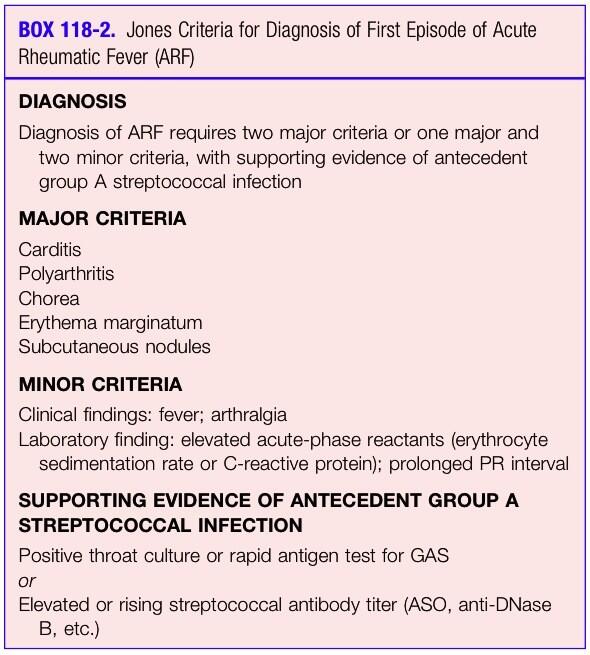 A throat culture takes a few days to get results. However, rapid step tests sometimes give false-negative results (saying you don’t have strep when you really do).
A throat culture takes a few days to get results. However, rapid step tests sometimes give false-negative results (saying you don’t have strep when you really do).
Depending on your symptoms, your healthcare provider may also order:
- Blood tests: Sometimes, providers order a blood test to confirm a strep infection. Blood tests can detect antibodies (your body’s defenses against the bacteria) when the bacteria no longer show up on tests. Other blood tests check for substances (like proteins) that show inflammation in the body.
- Heart tests: Heart tests, such as an electrocardiogram (EKG) or an echocardiogram (Ultrasound of the heart), help providers check your heart function.
Management and Treatment
How is rheumatic fever treated?
Rheumatic fever treatments first focus on getting rid of the bacterial infection. Treatments then address inflammation inside the body.
Rheumatic fever treatments include:
- Antibiotics: Healthcare providers prescribe antibiotics to treat the underlying bacterial infection.
 Some antibiotics are one injection (shot). Others you take by mouth for a week or more.
Some antibiotics are one injection (shot). Others you take by mouth for a week or more. - Anti-inflammatory medications: Your provider will likely recommend a medication, such as aspirin, to reduce inflammation (swelling) throughout the body. This medication may also relieve symptoms, such as joint pain. For severe symptoms, your provider may prescribe a stronger medication (corticosteroids) to fight inflammation.
- Other therapies: Rheumatic fever can affect people in different ways. Your provider may recommend other treatments based on how the condition affects you. In severe cases, you may need heart surgery or joint treatments to treat serious complications.
Prevention
How can I prevent rheumatic fever?
Treating strep throat and scarlet fever early is essential. It can prevent rheumatic fever. Strep throat and scarlet fever symptoms aren’t always obvious or easy to spot. Call your healthcare provider for guidance if your child has a sore throat for more than three days or has other symptoms that concern you.
If your child has strep throat or scarlet fever, make sure you follow your provider’s instructions carefully. Your child needs to finish the full course of antibiotics, even if they feel better. Otherwise, the infection may not go away and make you more prone to rheumatic fever.
What else can I do to protect against rheumatic fever?
Practicing good hygiene can reduce your chances of getting a bacterial infection. It can also stop you from spreading an infection to someone else. You should always:
- Wash your hands often (and well) with soap and water.
- Cough or sneeze into a tissue, your elbow or upper shoulder (not your hand).
- Use a tissue once for a sneeze or to blow your nose, then throw it away and wash your hands.
If you have been diagnosed with rheumatic fever, your physician may prescribe a long term antibiotic (monthly injections of penicillin) to prevent future bouts of strep throat and to prevent recurrences of rheumatic fever.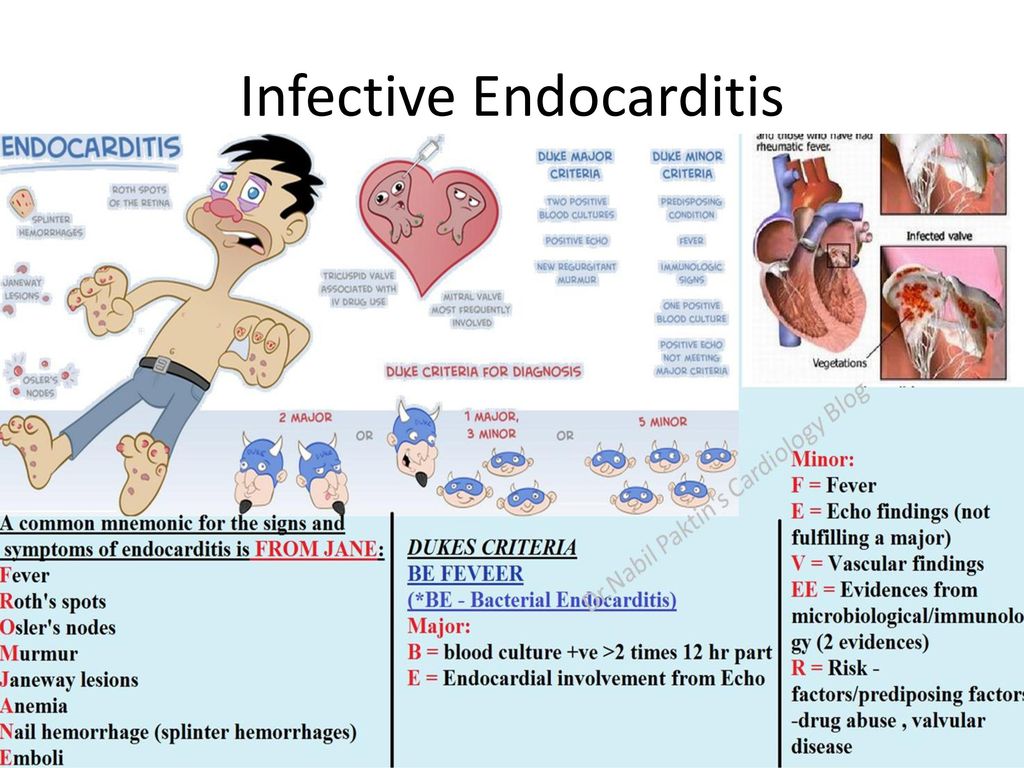
Outlook / Prognosis
What’s the outlook for people with rheumatic fever?
Rheumatic fever doesn’t have a cure, but treatments can manage the condition. Getting a precise diagnosis soon after symptoms show up can prevent the disease from causing permanent damage. Severe complications are rare. When they occur, they may affect the heart, joints, nervous system or skin.
Rheumatic disease can come back or become a serious problem. In some cases, rheumatic fever can lead to serious or even life-threatening complications. Your child may need regular checkups to protect their health long-term.
How does rheumatic fever affect the heart?
Rheumatic fever doesn’t always affect the heart. But when it does, it can damage heart tissues, especially the heart valves. Scarred heart tissue doesn’t work correctly. Over time, rheumatic fever may lead to permanent heart damage. Providers may call this condition rheumatic heart disease or congestive heart failure.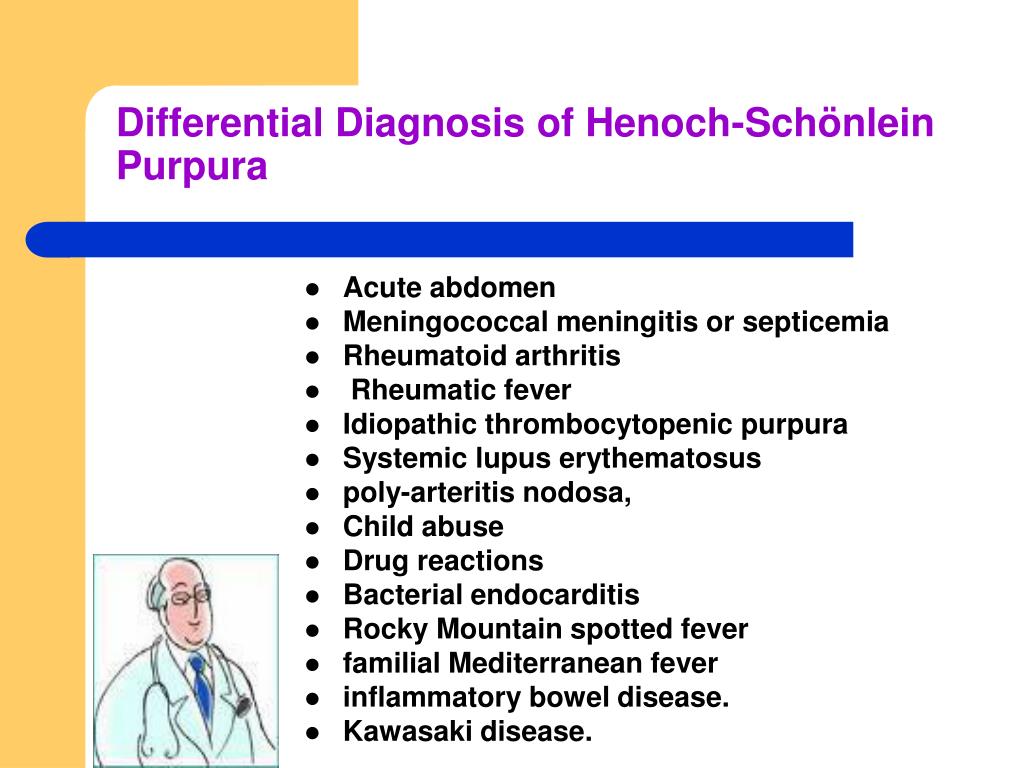
If rheumatic fever injures a heart valve, your provider may recommend surgery to repair or replace the affected valve. Heart damage may show up 10 to 20 years after a rheumatic fever diagnosis. It’s important to stay in regular contact with a healthcare provider you trust for the rest of your life.
Living With
Can rheumatic fever come back?
Yes. You can get rheumatic fever again if you get strep throat or scarlet fever again later. If you’ve had rheumatic fever, your provider may recommend you take antibiotics for years or possibly throughout your life. This treatment is called antibiotic prophylaxis. It can prevent another strep infection and keep rheumatic fever from coming back.
What should I ask my healthcare provider?
If you or your child has rheumatic fever, you may want to ask your provider:
- What antibiotic do you recommend?
- How long does my child need to take this medication?
- Will my child need to take antibiotics long-term?
- Will my child need other tests, now or in the future?
- How could rheumatic fever affect my child, now or in the future?
- Are there any activities that could pose a danger to my child’s health?
- What type of medical care will my child need moving forward?
- What can I do to best protect my child’s health?
When should I call the doctor?
If you suspect your child may have strep throat or scarlet fever, don’t wait to call your provider. Early treatment can prevent rheumatic fever.
Early treatment can prevent rheumatic fever.
Common signs of these bacterial infections include:
- Sore throat that lasts more than three days.
- Lack of appetite (especially if due to problems swallowing).
- Swollen lymph nodes on the neck.
- Red rash.
- Fever.
- Swollen, red, or spotted tonsils (glands in the back of the mouth).
- Headache.
A note from Cleveland Clinic
Rheumatic fever is a rare complication. It can happen when treatments don’t eliminate strep throat or scarlet fever. It most commonly affects young children and teens. In severe cases, it can lead to serious health problems that affect the heart, joints or other organs. You can prevent rheumatic fever by seeing your provider right away if you suspect one of these common bacterial infections. People with rheumatic fever often need lifelong medical care to protect their health.
90,000 Publications in the media
Acute rheumatic fever (ARF) is a systemic inflammatory disease of the connective tissue with involvement of the heart and joints in the pathological process, initiated by group A -hemolytic streptococcus, which occurs in genetically predisposed people.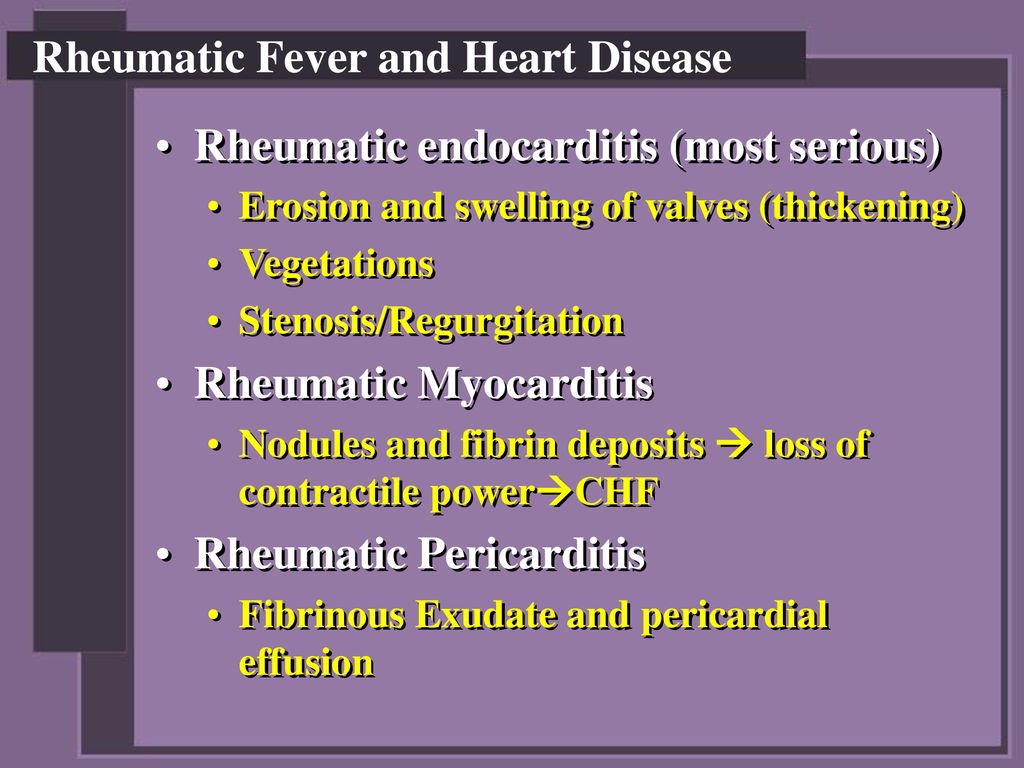 The term rheumatism, which is widely used in practice, is currently used to denote a pathological condition that combines acute rheumatic fever and rheumatic heart disease.
The term rheumatism, which is widely used in practice, is currently used to denote a pathological condition that combines acute rheumatic fever and rheumatic heart disease.
Statistics . Incidence: 2.1 per 100,000 population in 2001. The incidence of rheumatic heart disease in Russia is 0.17%. The predominant age is 8-15 years.
Etiology. -Hemolytic streptococcus group A, “rheumatogenic” serotypes M3, M5, M18, M24. M-protein on the membrane of streptococcus has antigenic determinants similar to components of the heart muscle, brain and synovium.
Genetic aspects .Ag D8 / 17 B-lymphocytes are detected in 75% of ARF patients.
Pathogenesis • Anti-streptococcal antibodies that cross-react with heart tissues (molecular mimicry) are responsible for selective damage to the heart valves and myocardium with the development of aseptic immune inflammation. processing by Ar-presenting cells and interaction with molecules of class II of the main histocompatibility complex.
Clinical picture
• Onset of the disease. In more than half of cases, 2-4 weeks after a streptococcal nasopharyngeal infection, fever, asymmetric joint pain, pain in the heart, shortness of breath, palpitations occur. In other patients, the debut proceeds as a monosyndrome (carditis, arthritis or chorea) • The repeated attack proceeds with symptoms of carditis.
• Arthralgia and rheumatic fever (80% of patients) – a typical reactive synovitis with fluid effusion into the joint cavity, swelling and redness of the periarticular tissues, sometimes with severe pain, soreness and limitation of active and passive movements.Special Features:
•• damage to large joints (knee [most often], ankle, elbow, shoulder, and much less often – wrist) •• symmetry of the lesion •• migratory, volatile arthritis •• complete reversibility of the articular syndrome, no changes on radiographs, recovery joint functions •• in children, the signs of arthritis, as a rule, completely disappear, and in adults, a persistent course can be observed leading to the development of Jaccoux syndrome (painless deformity of the hands with ulnar deviation without inflammation in the joints and without dysfunction of the joint) •• rheumatism, more often with repeated attacks, often there is not arthritis, but polyarthralgia.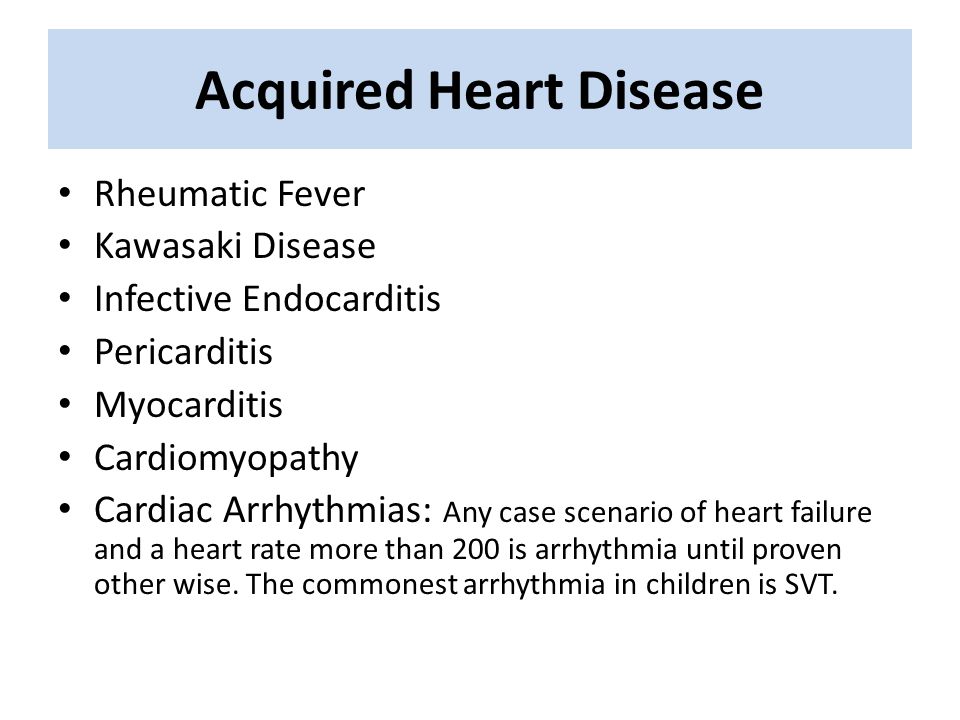
• Fever (90%).
• Subcutaneous nodules (10% of patients) from grain to pea in size with localization in periarticular tissues may appear during acute rheumatic fever. These nodules do not bother patients, they are painless, the skin over them is not changed. The involution of nodules occurs over a period of several days to several weeks. Observed only in children.
• Ring-shaped erythema – pale pinkish-red spots up to 5-7 cm in diameter with clear, not always even edges.Characterized by localization on the skin of the chest, abdomen, back and extremities, spontaneous disappearance and (rarely) recurrence. Occurs in less than 5% of patients. Erythema nodosum is not typical for rheumatism.
• Chorea occurs in 10-15% of patients, more often in girls, 1-2 months after a streptococcal infection. It is a chaotic involuntary twitching of the limbs and facial muscles. Complete disappearance of symptoms during sleep is characteristic.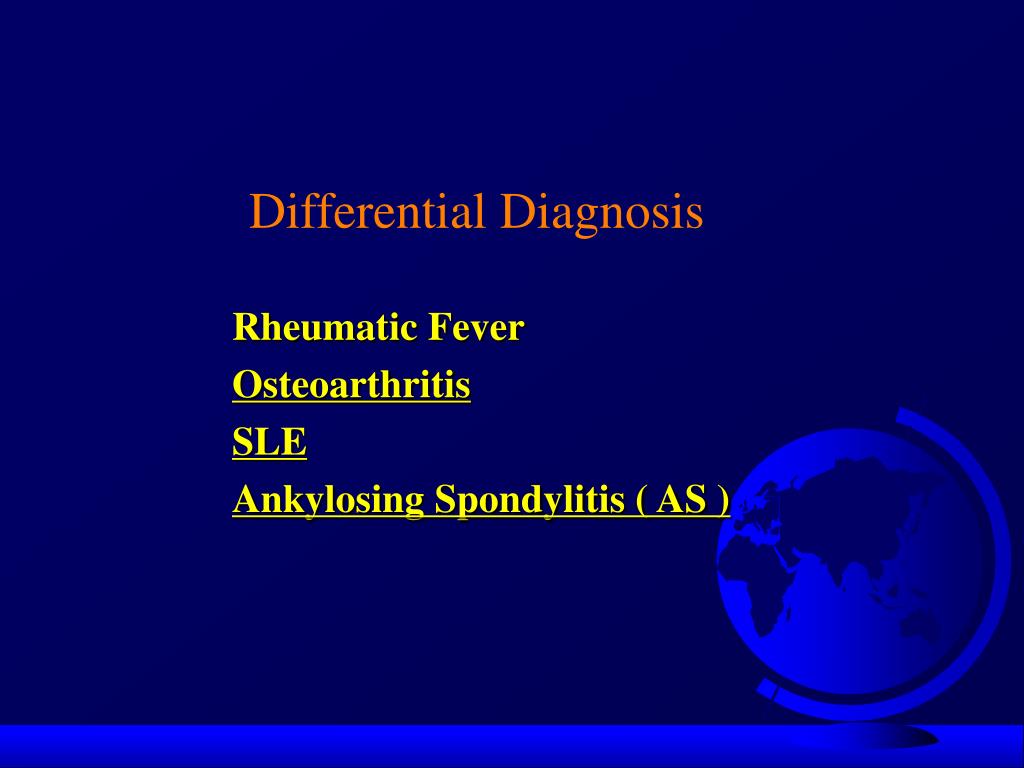
• Rheumatic carditis (rheumatic heart disease) can be primary (first attack) and recurrent (repeated attacks), with or without the formation of valvular disease.Clinical symptoms of rheumatic heart disease:
•• Cardialgia . Characterized by prolonged stitching, aching pains in the region of the heart, usually without irradiation. With pericarditis, pain is associated with breathing, intensified in a horizontal position.
•• In most cases, is noted an increase in the heart , which is not always detected physically. Chest x-rays are recommended.
•• Arrhythmias as a manifestation of myocarditis ••• Sinus tachycardia (100 or more per minute), recorded at rest ••• Atrial fibrillation occurs, as a rule, when signs of mitral valve stenosis appear ••• Ventricular (rarely) or supraventricular extrasystoles ••• Atrioventricular block with lengthening of the P – Q interval over 0.2 s or the appearance of Wenckebach (Samoilov – Wenckebach) periods.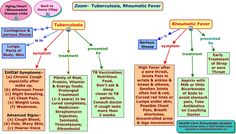
•• Decrease in sonority of the first tone at the apex of the heart, the appearance of a third tone and noises. A gentle blowing systolic murmur with a tendency to increase in intensity and conducted into the axillary region is a symptom of mitral valvulitis. A protodiastolic murmur along the left edge of the sternum is a sign of aortic valvulitis.
•• Signs of congestive heart failure are rarely observed in primary rheumatic heart disease, much more often they accompany recurrent rheumatic heart disease.
• Acute rheumatic fever lasts 6–12 weeks. There is no chronic or continuously recurrent course.
Laboratory data • Increased ESR, increased titers of antistreptolysin O, AT to DNase in a titer of more than 1: 250 • Bacteriological examination of a smear from the throat reveals -hemolytic streptococcus group A.
Instrumental data • ECG • Chest X-ray • Echocardiography …
Differential diagnosis • Reactive arthritis • Lyme disease • Infective endocarditis • Viral (Coxsackie B) myocarditis • Mitral valve prolapse • Functional heart murmurs.
Criteria for the diagnosis of Kissel-Jones-Nesterov (revised in 1992) • Large criteria: •• carditis •• polyarthritis •• chorea •• annular erythema •• subcutaneous nodules • Small criteria: •• clinical symptoms (fever, joint pain) •• laboratory changes (increased ESR, the appearance of CRP, lengthening of the P – Q interval •• Additional signs: positive cultures from the tonsils for -hemolytic group A streptococcus, an increase in titers of antistreptolysin-O and / or other anti-streptococcal antibodies.
The presence of two large or one large and two small criteria in combination with the obligatory presence of additional signs allows the diagnosis of acute rheumatic fever to be considered reliable.
Despite the existence of time-tested criteria, the diagnosis of ARF continues to be a problem, since individual criteria (fever, ESR, etc.) are not specific, and subcutaneous nodules and erythema annulus are rarely observed.
TREATMENT
Management tactics . In acute rheumatic fever, hospitalization, bed rest, a diet low in salt and rich in vitamins and protein are indicated. The basis of drug treatment is antibacterial and anti-inflammatory therapy.
In acute rheumatic fever, hospitalization, bed rest, a diet low in salt and rich in vitamins and protein are indicated. The basis of drug treatment is antibacterial and anti-inflammatory therapy.
Drug treatment • Antibiotic therapy •• Benzylpenicillin 1.5-4 million U / day for adolescents and 400-600,000 U / day for children for 10-14 days, followed by switching to benzathine benzylpenicillin or benzathine benzylpenicillin + benzylpenicillin procaine •• If you are allergic to penicillins, you should choose a macrolide: roxithromycin for children 5–8 mg / kg / day, adults 150 mg 2 r / day, clarithromycin for children 7.5 mg / kg / day, adults 250 mg 2 r / day.It should be remembered that streptococcus resistance is currently increasing to erythromycin.
• NSAIDs for 3.5-4 months (during treatment it is necessary to periodically conduct blood tests, urine tests, liver function tests) •• Diclofenac 50 mg 3 r / day.
• The appointment of GC is most justified in case of pancarditis.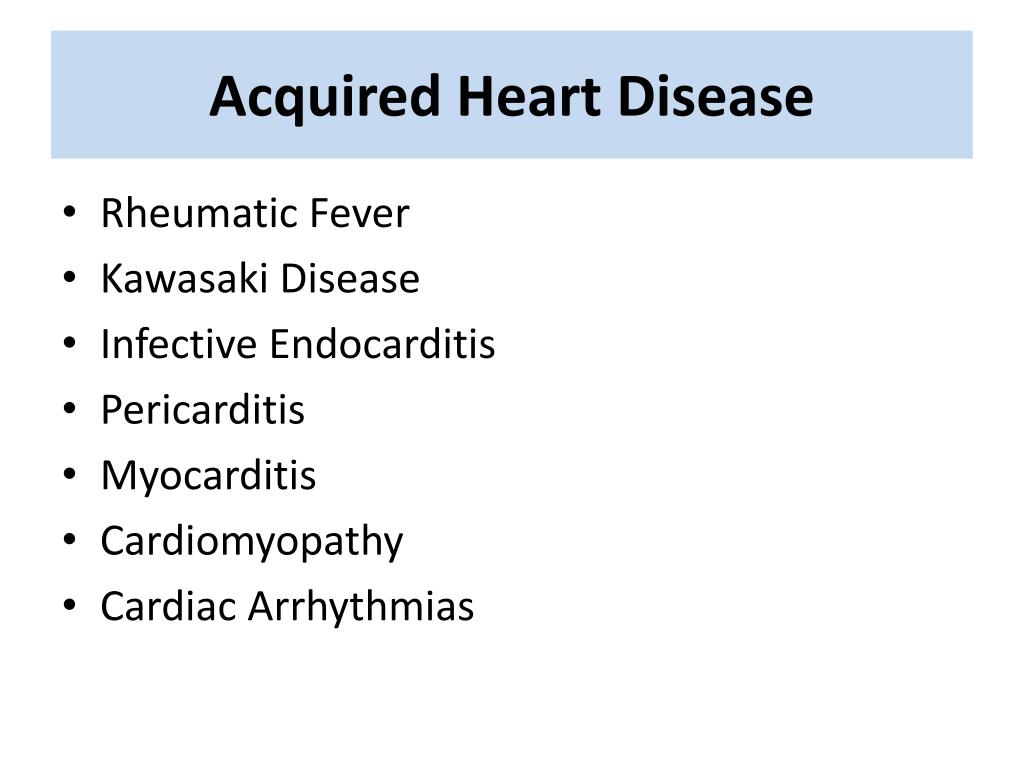 One of the treatment regimens is prednisolone 20-30 mg / day until the clinical effect, then a gradual dose reduction for 20-30 days.
One of the treatment regimens is prednisolone 20-30 mg / day until the clinical effect, then a gradual dose reduction for 20-30 days.
Prevention
• Primary prevention : rational treatment of streptococcal diseases of the oropharynx for 10 days •• Aminopenicillins ••• Amoxicillin 750 mg / day for children, 1500 mg / day for adults •• Cephalosporins ••• Cephalexin for children with body weight <40 kg - 25-50 mg / kg / day, adults 250-500 mg 2-4 r / day (daily dose 1-2 g) ••• cefaclor children 20 mg / kg 3 r / day, adults 750 mg 3 r / day ••• cefuroxime for children 125-250 mg 2 times / day, for adults 0.25-0.5 g 2 times / day •• Macrolides ••• Roxithromycin for children 5-8 mg / kg / day, adults 150 mg 2 r / day •• Penicillins with β-lactamase inhibitors ••• amoxicillin + clavulanic acid (adults 375 mg 3 r / day) for 10 days.
• Secondary prophylaxis is indicated for patients with acute rheumatic fever in order to prevent relapse. The best results are obtained with year-round bicillin prophylaxis (benzathine benzylpenicillin, 600,000-1200,000 U (children), 2,400,000 U (adults) 1 time in 3 weeks. Benzatin benzylpenicillin + benzylpenicillin procaine, 1,500,000 U, 1 time in 10-12 days. Duration of secondary prevention •• at least 5 years after the last reliable rheumatic attack for patients who have suffered acute rheumatic fever without carditis •• more than 5 years – for patients who have had rheumatic carditis •• with relapses for life.
The best results are obtained with year-round bicillin prophylaxis (benzathine benzylpenicillin, 600,000-1200,000 U (children), 2,400,000 U (adults) 1 time in 3 weeks. Benzatin benzylpenicillin + benzylpenicillin procaine, 1,500,000 U, 1 time in 10-12 days. Duration of secondary prevention •• at least 5 years after the last reliable rheumatic attack for patients who have suffered acute rheumatic fever without carditis •• more than 5 years – for patients who have had rheumatic carditis •• with relapses for life.
• Prevention of infective endocarditis against the background of formed rheumatic heart disease during any surgical interventions (tooth extraction, abortion, abdominal surgery) – see Infectious endocarditis.
Synonym . Sokolsky – Buyo’s disease.
Abbreviations. ARF – acute rheumatic fever.
ICD-10 • I00 Rheumatic fever without mention of cardiac involvement • I01 Rheumatic fever with cardiac involvement
90,000 “He shuddered and fell dead” The ingenious Mozart died at 35. The mystery of his death has not been solved for more than 200 years: Books: Culture: Lenta.ru
The mystery of his death has not been solved for more than 200 years: Books: Culture: Lenta.ru
In history, the fear of high-ranking persons before poisoning peacefully coexisted with the regular use of poisons in everyday life. Cosmetics, medicines, and grooming procedures were often no less dangerous for the body than deliberate attempts to cause harm. In October, Bombora publishes a book by Eleanor Herman, The Elegant Science of Poisons from the Middle Ages to the Present. As drugs, cosmetics and food served as a method of sophisticated reprisals. “With the permission of the copyright holders “Lenta.ru” publishes a fragment of the text dedicated to the death of Wolfgang Amadeus Mozart.
November 20, 1791 Wolfgang Amadeus Mozart, thirty-five years old, went to bed in his Viennese apartment with a fever. Most likely, it did not bother him very much. Since childhood, he has experienced many serious illnesses: smallpox, jaundice, typhus, tonsillitis, stomach upset, recurrent pharyngitis and upper respiratory tract infections. He always came back with new creative energy, ready to dazzle the world with his music.
He always came back with new creative energy, ready to dazzle the world with his music.
However, this time it will be different. After the terrible circumstances of the death of the great composer on December 5 – swollen flesh that exuded a sickening stench, a mutated puffy face, almost unrecognizable – rumors circulated that he was poisoned by an envious and vengeful rival, also a musician at the Austrian imperial court, Antonio.
The rapid development of classical music at the end of the 18th century gives no reason to suspect forgery. It was an era when the most talented composers fought desperately for several court positions, an era of gold lace and diamond buttons, satin knee-length breeches and silk coats, which hid villainous ambition, betrayal, dirty tricks, treason and conspiracies.
Mozart knew this world from an early age. His father Leopold served as vice-conductor (that is, music director) at the court of the Prince-Archbishop of Salzburg and taught music to both children – Anna Maria, whose home name was Nannerl, who was born in 1751, and Wolfgang, who was born in 1756. Under the strict tutelage of his father, Wolfgang began playing the harpsichord at the age of three. At five he was already composing his own melodies. Ever since Wolfgang turned six, Leopold traveled for several years to the magnificent courtyards of Europe, accompanied by his wife and children, monetizing his prodigies.Nannerl played beautifully, but little Wolfgang, charming and self-confident, amazed the audience with his talent – he could even play while blindfolded.
Under the strict tutelage of his father, Wolfgang began playing the harpsichord at the age of three. At five he was already composing his own melodies. Ever since Wolfgang turned six, Leopold traveled for several years to the magnificent courtyards of Europe, accompanied by his wife and children, monetizing his prodigies.Nannerl played beautifully, but little Wolfgang, charming and self-confident, amazed the audience with his talent – he could even play while blindfolded.
(…)
At twenty-five, Wolfgang decided it was time to get out of his father’s control and spread his wings – both in a human and musical sense. In March 1781, he arrived in Vienna, the capital of the Austrian Empire, a city that offered countless musical possibilities. It had 300,000 residents, many concert halls, music academies and a talented community.
And finally, this very place became his home.
Shot: the film “Amadeus”
Mozart earned money performing in academies, at subscription concerts and in the homes of patrons. He gave private piano lessons – although it is difficult now to imagine a person who would take lessons from Mozart himself – and wrote music. But in the end, he worked much harder than others and earned much less than many musicians who did not possess his genius.
He gave private piano lessons – although it is difficult now to imagine a person who would take lessons from Mozart himself – and wrote music. But in the end, he worked much harder than others and earned much less than many musicians who did not possess his genius.
Mozart’s main rival in Vienna was Antonio Salieri, a successful Italian composer who wrote operas in three languages.He captured the Vienna Opera and in 1788, when Mozart was already building an adult career, was appointed Imperial Kapellmeister.
Mozart wrote several letters to his father complaining that Salieri and his henchmen were blocking all his attempts to get an official position.
For example, in 1781, when Mozart hoped that the emperor would hire him to teach the piano to Princess Elizabeth of Württemberg (the bride of the emperor’s nephew), Joseph gave this position to Salieri. “The emperor ruined everything,” Mozart wrote bitterly, “because he doesn’t care about anyone but Salieri.”
Shot: the film “Amadeus”
Nevertheless, Mozart and Salieri seemed to mutually respect each other’s musical talent. In 1785 they composed a cantata together, in 1788 Salieri staged Mozart’s Figaro at court instead of one of his operas. When he first attended the performance of Mozart’s “Magic Flute” in 1791, Salieri listened with great zeal, and there was not a single fragment, from the overture to the last chorus, that did not cause him to exclaim “bravo!” or “excellent!”
In 1785 they composed a cantata together, in 1788 Salieri staged Mozart’s Figaro at court instead of one of his operas. When he first attended the performance of Mozart’s “Magic Flute” in 1791, Salieri listened with great zeal, and there was not a single fragment, from the overture to the last chorus, that did not cause him to exclaim “bravo!” or “excellent!”
Unlike the serious, detailed Salieri, Wolfgang was not an impressive figure.One of the students wrote about Mozart: “… small in stature and rather pale, very pleasant in physiognomy and friendly, in features melancholic seriousness, and blue eyes shine brightly.”
Milos Forman’s 1984 film Amadeus captures the manic side of Mozart’s character: a penchant for practical jokes, the habit of letting go of dirty wit, love to laugh.
In 1782, he wrote a canon in B flat major called Lick my ass well and clean.
(…)
In 1782, at the age of twenty-six, Mozart did what Leopold had always feared – he got married.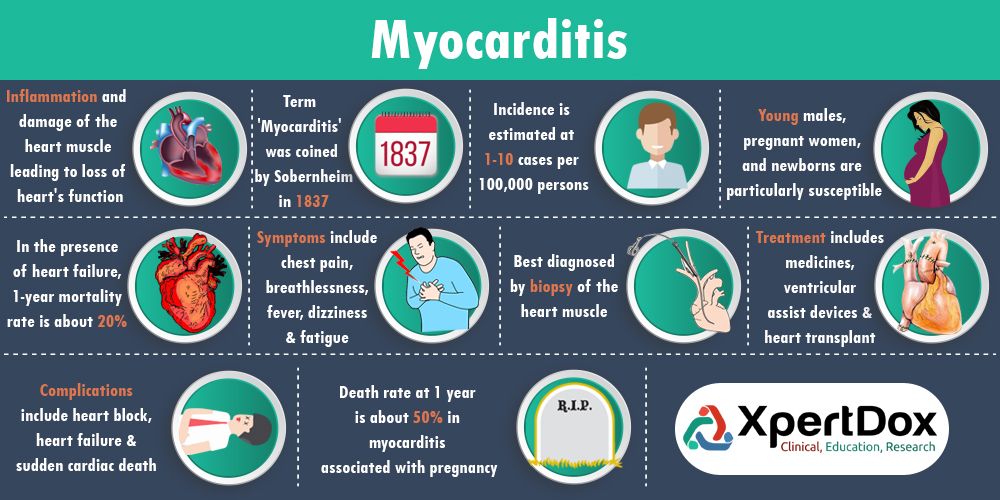 He met Constance Weber and her family several years ago in Mannheim, Germany, during a trip with his mother. Leopold was enraged by Wolfgang’s apparent crush on the eldest of the four sisters, Aloisia, and, without even meeting them, claimed that a greedy family was trying to lure his talented son into a trap in order to get money. Now, four years later, Mozart has reunited with the Weber in Vienna, where they moved, and fell in love with a third sister.
He met Constance Weber and her family several years ago in Mannheim, Germany, during a trip with his mother. Leopold was enraged by Wolfgang’s apparent crush on the eldest of the four sisters, Aloisia, and, without even meeting them, claimed that a greedy family was trying to lure his talented son into a trap in order to get money. Now, four years later, Mozart has reunited with the Weber in Vienna, where they moved, and fell in love with a third sister.
Leopold was probably beside himself when he received the engagement newsletter.Now, because of one woman, his son was forever deprived of power. After the wedding, father and son saw each other only twice, and both visits were very uncomfortable. Leopold died in 1787 at the age of sixty, and Mozart did not come to say goodbye when he was ill, and did not attend the funeral.
Ironically, shortly after Leopold’s death, Wolfgang finally got the official seat at court that his father so wanted to knock out for him.
Joseph II hired Mozart as a chamber musician to write the minuets.
In recent years, with the composition of four successful operas, Mozart’s income has grown significantly. However, he always lagged behind in paying bills, as he spent on clothing, fine dining, gifts for Constance, and gambling.
In the fall of 1791, Mozart enjoyed being healthy, writing in letters about the delicious food he ate – pork cutlets, capons, sturgeon – and, in frantic creative impulses, composed great new music. Perhaps his loved ones were not surprised to learn that the exhausted musician had a fever.
Shot: the film “Amadeus”
However, this disease, unlike the others, did not pass. When Mozart was swollen to such a grotesque degree that he could not move, his wife and her sister Sophia sewed him a special dress that unbuttoned at the back, so that it would be easier to put up the chamber pot and wash away the great composer.
On December 4, he began to rave.
Two doctors pumped out two to three liters of blood from Mozart, which reduced the body’s ability to resist infection.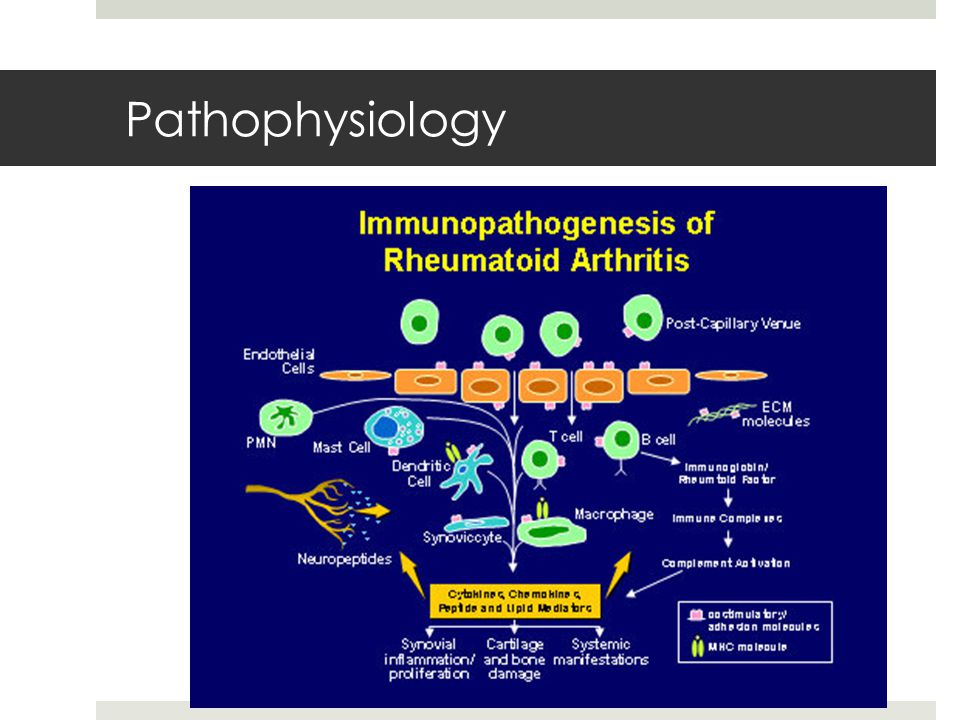 The next day, Mozart shuddered, then vomited brown liquid, and fell down dead.
The next day, Mozart shuddered, then vomited brown liquid, and fell down dead.
The widow Constance secretly told her friends that her husband had died of a fever. However, left with two children in her arms, a mass of debts and no income, she publicly supported the rumor about the poison in order to evoke sympathy in society. She spoke of a mysterious masked stranger who allegedly ordered a funeral mass. According to this legend, Mozart fell seriously ill while working on the piece.
“I know I’m about to die,” she said, said Mozart. “Someone must have given me aqua-tofan and calculated the exact time of my death, so that it turns out that I am writing a requiem for myself.”
The truth was much more banal. A few months before Mozart’s death, the eccentric Count Franz von Walsegg ordered the composer a funeral Mass in memory of his recently deceased wife. There was secrecy, since the count — an amateur musician — wanted to make it appear as if he had written the requiem himself.
Without going into the facts, Constance received a pension from the emperor and profits from concerts at which her late husband’s music was played. It is much more interesting to listen to the compositions of someone who was mysteriously killed than someone who died of a natural disease. She very soon and solidly enriched herself at the death of Mozart.
Shot: the film “Amadeus”
The majority blamed Salieri, Mozart’s main rival. In the last surviving letter, dated October 14, 1791, Mozart wrote (from Prague, where the courtyard was at that time) that he went to the opera with Salieri and the soprano Catarina Cavalieri.Salieri could, for example, offer Mozart a flask of alcohol while they rode in the carriage, or add something to his wine when they discussed opera at dinner.
Salieri never denied rumors of poisoning, but took over the musical education of Mozart’s son. Under his leadership, Franz Xaver Wolfgang Mozart developed into a renowned composer and conductor.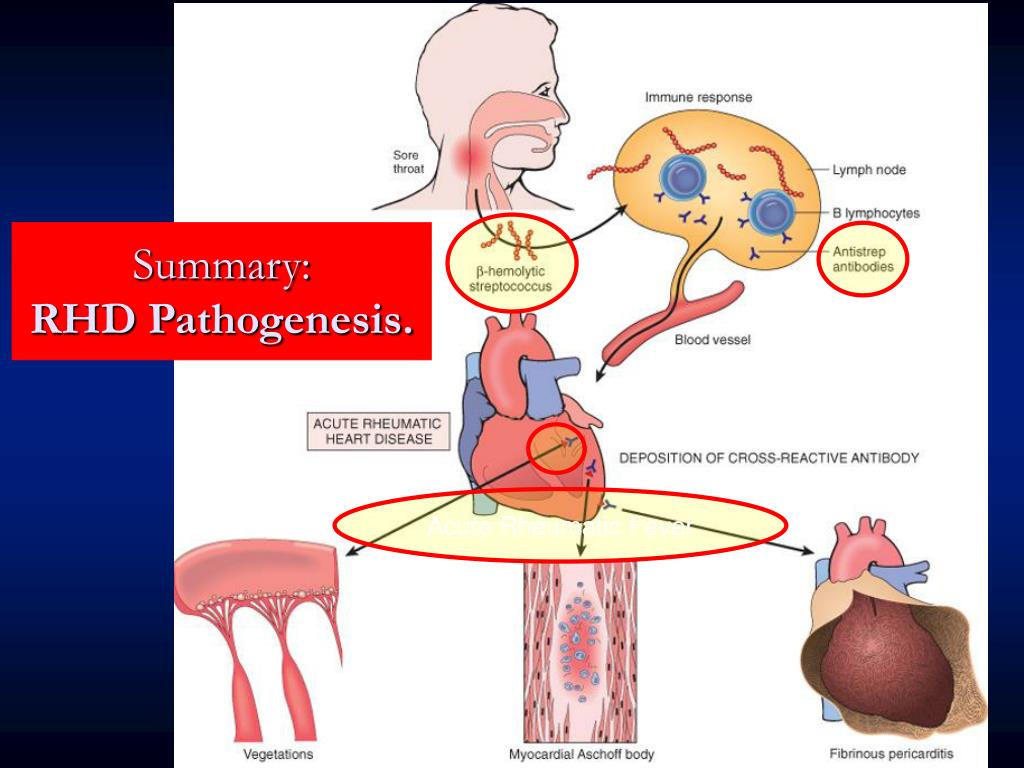
Towards the end of his life, Salieri, suffering from periodic attacks of dementia, confessed to the murder of Mozart, but denied this in moments of enlightenment.
In 1823, one of Ludwig van Beethoven’s students, Ignaz Moscheles, visited a seventy-four-year-old Salieri who was ill at a public hospital in the vicinity of Vienna.
The composer hastened to report: “Although I will not survive this illness, I can assure you that there is not a drop of truth in the ridiculous rumors. You know that they blame me for Mozart’s death, but this gossip is just malice, pure malice, and pass it on to the whole world, dear Moscheles, as the dying Salieri told you. ”
Shot: the film “Amadeus”
According to another theory, Mozart was poisoned by the Masonic order, because in 1784 in the play “The Magic Flute” he revealed many of their secrets.However, the fellow Freemasons, not denigrating Mozart, actually set up a Lodge of Sorrows in his memory. The author of the libretto for The Magic Flute, Emanuel Schikaneder (also a Freemason), lived another twenty-one years without being attacked.
The most ridiculous part of the murder story is that all over Vienna people were dying of the same disease that killed Mozart. The cause of death of the composer is indicated as “acute military fever”, and no one knows exactly what it is, although researchers have come up with at least 188 versions.One of them implies that we are talking about acute rheumatic fever, but in this case the patient has shortness of breath – which is not mentioned in the reports on the course of Mozart’s disease. In addition, ARF tends to occur in children and in adults is accompanied by joint pain rather than swelling. Given the swelling and stench, we can conclude that Mozart’s kidneys failed: the body does not excrete waste with urine, they accumulate in the bloodstream and are excreted in sweat, saliva, etc., until the whole body begins to smell of urine – the so-called uremic stench …However, not all kidney diseases would cause Mozart to swell so severely.
There is a disease that explains all the symptoms.
Streptococcus equi, a group C streptococcus, attacks the glomeruli – microscopic renal filters, so that waste does not enter the urine, but is carried throughout the body. As the name suggests, it is primarily a disease of horses and cows. But, like anthrax, it is highly contagious to both animals and humans. Mozart, riding in carriages, often dealt with horses and, perhaps, had the habit of drinking unpasteurized milk.
Unfortunately, there is no autopsy report left in the archives to help us understand the reasons better. According to the doctors, the matter was clear: an epidemic of acute military fever. Even if the relatives were willing to conduct an autopsy, the body, swollen and fetid, was in a terrible state, possibly contagious, and even the most persistent doctor probably would not want to do an autopsy.
Remains that could be studied have not survived either. Following the principles of egalitarianism imposed by the Great French Revolution, Joseph II tried to prohibit lavish funerals and passed laws.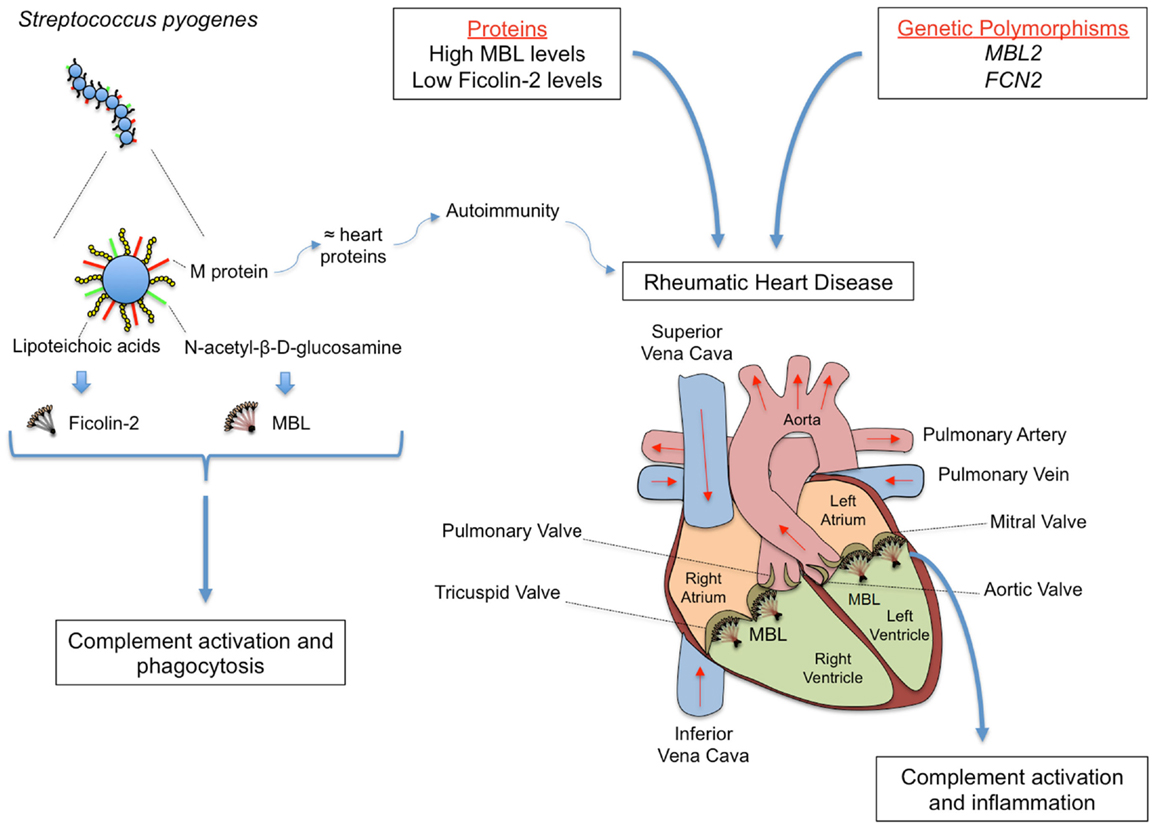 Therefore, the remains of Mozart were transported at night to the cemetery of St. Mark, no funeral procession took place, and none of the family members saw the burial place. In addition, according to Joseph’s decree, the coffins of the “middle class” were placed in five pieces in one grave pit, so that ten years later they would be dug out and make room for new coffins.
Therefore, the remains of Mozart were transported at night to the cemetery of St. Mark, no funeral procession took place, and none of the family members saw the burial place. In addition, according to Joseph’s decree, the coffins of the “middle class” were placed in five pieces in one grave pit, so that ten years later they would be dug out and make room for new coffins.
The sexton of St. Mark’s Church, a certain Joseph Rotmeyer, claimed to have marked the place where the famous composer was buried. Ten years after Mozart’s death, in 1801, Rothmeier, as expected, dug up the bones and proudly exhibited the skull for everyone to see (today it is in the Mozart Museum in Salzburg).Unfortunately, Rotmeyer dug up the wrong corpse. A skull without a jaw has clear signs of a fracture, and no one broke Mozart’s skull bones.
However, some historians, departing from any logic, believe that this skull is direct evidence that Mozart actually died from a blow to the head.
The theory faded in 2006 when researchers compared mitochondrial DNA extracted from a skull bone with DNA taken from the thigh bones of Mozart’s maternal grandmother and niece.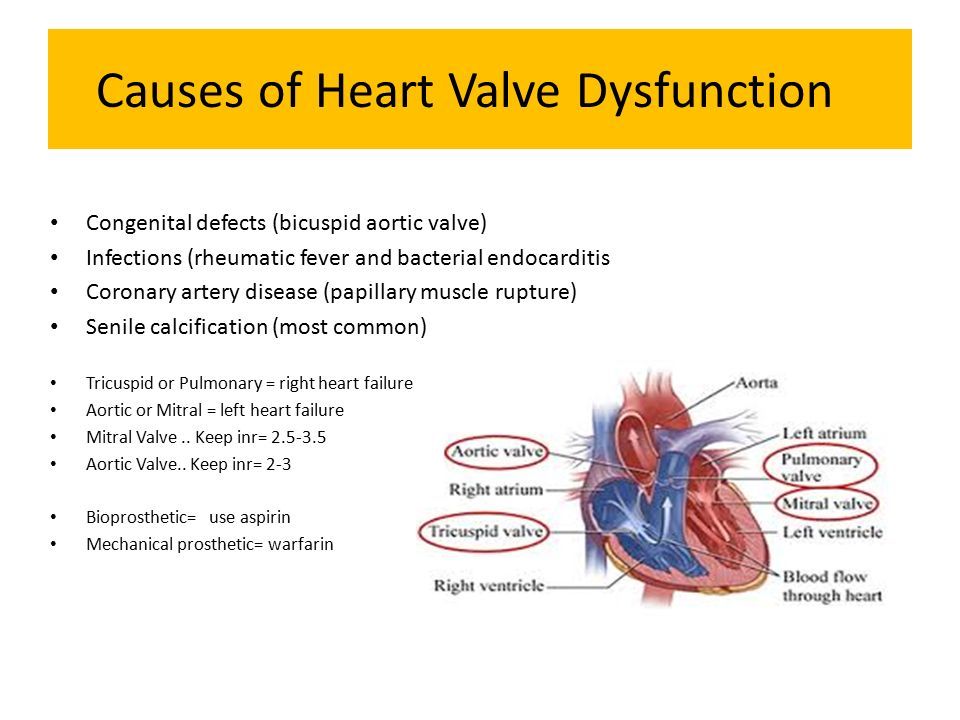
Analysis confirmed no genetic similarity. We may never know for sure what killed Mozart (but certainly not the blow to the head), but that hardly matters. The only thing that matters is that he lived and continues to live in his magically beautiful music.
And although we are grateful that such a vast legacy remained after Mozart – 626 works, operas, symphonies, string quartets, minuets, masses, piano concertos – we still grieve how much we have lost because of his untimely death at thirty-five years old.This heartbreakingly exquisite music, etched into eternity, remains out of our reach.
Cardiology department
The key to the successful work of the cardiology department is professional growth in order to improve the quality of specialized medical care, modern equipment and emotional attitude towards patients, the use of new methods of diagnosis and treatment.
Development history
In 1994with the opening of the AODKB as part of the endocrine-gynecological department, 20 cardiological beds were opened. As an independent specialized department, the only one in the Amur Region, it was organized in 1998 under the leadership of a doctor of the highest category N.B.Danilova. In 2005, the department was replenished with 10 beds of young age.
As an independent specialized department, the only one in the Amur Region, it was organized in 1998 under the leadership of a doctor of the highest category N.B.Danilova. In 2005, the department was replenished with 10 beds of young age.
Branch today
The Cardiology Department has cardiology, rheumatology and early age beds.In addition, patients are offered such forms of diagnosis and treatment as a day hospital. Children of the Amur Region and the city of Blagoveshchensk are hospitalized.
The department was created to treat congenital heart defects, rheumatic diseases at all stages of the development of the child’s body, with the subsequent development of an individual program of prevention and treatment. Also, assistance is provided to the pediatric profile for children under 3 years of age.
The department takes an active part in the creation of the Unified Russian register of patients with juvenile rheumatoid atritis, who are regularly sent to the Children’s Health Center in St.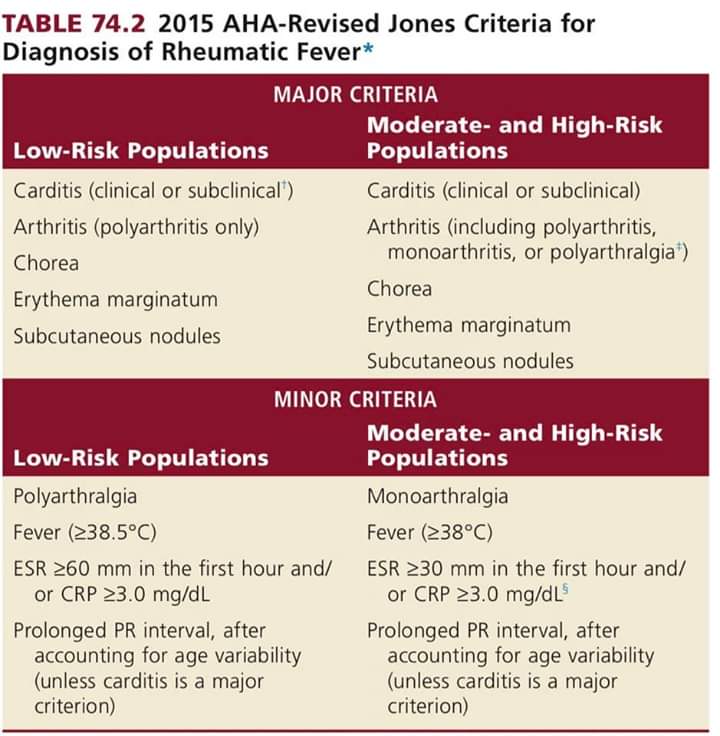 Moscow.
Moscow.
The team of the department is stable. Almost all doctors and nurses have the highest qualification category.
Doctors of the department have the opportunity to consult with doctors of central clinics by registering on the website “Remission. ru “.
In parallel with remicade, for the first time in 2012, the department began therapy with two new drugs from the group of tumor necrosis factor inhibitors – humira, enbrel.The use of drugs made it possible to avoid the disability of this group of patients.
Types of medical care.
The department carries out examination and treatment of children:
Cardiac profile:
- With carditis of various etiology.
- Congenital and acquired heart defects.
- Disturbances of heart rhythm and conduction of various etiologies.
- Autonomic dysfunction syndrome (VVD) of various types.
- Metabolic disorders of the myocardium of various etiology.

Rheumatological profile:
- Acute rheumatic fever.
- Diffuse connective tissue diseases (systemic sclerosis, polymyositis, systemic lupus erythematosus, periarteritis nodosa and other collagenoses).
- Rheumatoid arthritis in children and adolescents.
- Arthritis of various etiologies (except traumatic).
- Reactive arthritis of various etiologies.
- Juvenile chronic arthritis.
- Infectious-allergic arthritis.
Pediatric Profile for Young Children:
- Anemias of various origins.
- Eating disorders.
- Phenylketonuria.
- Disorders of mineral metabolism.
Thanks to the introduction of the latest generation of COX-2 inhibitors into the basic therapy (Movalis, Celebrex, Nimesulide, the transition to a more modified administration of the drug methotrexate) in the treatment of rheumatological patients, the hospitalization time has been significantly reduced.
The cardiology department maintains close ties with central clinics. The selection of children in need of high-tech medical care is carried out on a regular basis. The most demanded clinics are the Institute of the Union of Artists named after V.I. Bakuleva, Research Institute of Pediatrics, Research Institute of Rheumatology, Institute of Circulatory Pathology in Novosibirsk, Institute of Cardiology of the Siberian Branch of the Russian Academy of Medical Sciences in Tomsk.
Children with congenital heart defects, with various rhythm disturbances are sent to the central clinics for the necessary surgical interventions.Examination on the basis of AODKB and subsequent surgical treatment in central clinics is free of charge. For surgical treatment, quotas are allocated by the Ministry of Health of the Russian Federation.
Sitemap
Page not found. Perhaps the sitemap will help you.
- home
- The university
- About the university
- Structure
- Regulations and procedures
- Healing activities
- The international cooperation
- Press center
- news
- Announcements
- Developments
- Announcements and congratulations
- Online conferences
- Photo album
- Festive concert dedicated to Mother’s Day
- The ceremony of signing an agreement on cooperation between the university and the Grodno Orthodox diocese
- Dialogue platform with Chairman of the Grodno Regional Executive Committee Vladimir Stepanovich Karanik
- Exhibition-presentation of institutions of higher education “Education of the future”
- Friendly futsal tournament
- Conference “Modern Problems of Radiation and Environmental Medicine, Radiation Diagnostics and Therapy”
- Initiation into freshmen-2021
- Meeting of the Deputy Minister of Health D.V. Cherednichenko with students
- Open dialogue dedicated to the 19th anniversary of the Belarusian Republican Youth Union
- Retraining group in the specialty “Health Organization”
- Freshmen Faculty Meetings 2021
- Knowledge Day – 2021
- University Council
- Students of the Military Department of the Grodno State Medical University took the oath
- Liberation Day Grodno-2021
- Renovation and finishing works
- Final Practice in Military Training
- Independence Day-2021
- Students of the military department of the State Medical University: final practice-2021
- Graduation from the Faculty of General Medicine-2021
- Graduation from medical-psychological and medical-diagnostic faculties-2021
- Graduation of the Faculty of Pediatrics-2021
- Graduation Faculty of Foreign Students-2021
- Graduation 2021
- Requiem meeting dedicated to the 80th anniversary of the beginning of the Great Patriotic War
- Action “Memory” dedicated to the 80th anniversary of the beginning of the Great Patriotic War
- Republican student track and field race “At the start, youth!”
- Current issues of food hygiene
- Solemn event for the Day of Medical Workers-2021
- University Council
- Visiting meeting of the Republican Council of Rectors
- Ceremony of awarding medals and special certificates to graduates of 2021
- Prevention of destructive manifestations in the student environment and the influence of aggressive information content on the Internet
- Online exhibition “Remember so as not to repeat”
- Regional interuniversity conference “The feat of the people is immortal”
- Final of the first Republican intellectual tournament ScienceQuiz
- Conference “Topical issues of comorbidity of diseases in outpatient practice: from prevention to treatment”
- Family Day 2021
- Dialogue platform with the chairman of the Grodno Regional Council of Deputies
- Festive city events for Victory Day
- Regional stage of the competition “Queen of Students-2021”
- Festive concert by May 9, 2021
- IV Republican civil-patriotic marathon “Together – for a strong and prosperous Belarus!”
- University Cup KVN-2021
- Musical planet of students (completion of FIU Days-2021)
- Youth round table “We are different, but we are together”
- FIU Days 2021.Intellectual game “What? Where? When?”
- Donation week at GrSMU
- Creative living room. FIU Days 2021
- Opening of the XVIII Student Festival of National Cultures
- Mobile multimedia exhibition “Partisans of Belarus”
- Republican subbotnik-2021
- Seminar “The Man Within Himself”
- International competition “Healthy lifestyle through the eyes of different generations”
- Presentation of the badge “Border Guard’s Wife”
- Meeting with representatives of the Medical University of St.Lublin
- Queen of Students of the GrSMU – 2021
- Open Doors Day 2021
- Personal finance management (meeting with representatives of BPS-Sberbank)
- Spring “Melotrek”
- Festive concert for March 8
- Dialogue platform with the chairman of the Grodno Regional Executive Committee
- Extended meeting of the university council
- Grodno – Youth Capital of the Republic of Belarus-2021
- A solemn meeting timed to coincide with the Defender of the Fatherland Day
- Presentation of a certificate of a full member of the Belarusian Chamber of Commerce and Industry
- New Year’s ScienceQuiz
- Final IV of the ScienseQuiz Three Universities Tournament
- Regional stage of the competition “Student of the Year 2020”
- Distance learning seminar for university staff from Belarus “Quality assurance of medical education and education in the field of public health and health care”
- Student of the Year – 2020
- Knowledge Day – 2020
- Awarding ceremony for the Government Prize for Quality
- Military oath
- Graduation from the Faculty of General Medicine-2020
- Graduation from the Faculty of Medicine and Psychology-2020
- Graduation of the Faculty of Pediatrics-2020
- Graduation from the Faculty of Foreign Students 2020
- Distribution – 2020
- Stop coronavirus!
- Towards spring 2020
- Career guidance – 18th International Specialized Exhibition “Education and Career”
- Spartakiad among employees “Health 2020”
- Conference “Actual problems of medicine”
- Opening of the hostel number 4
- Meeting of the President of Belarus with students and teachers of medical universities
- New Year’s party at the State Medical University
- XIX Republican student conference “Language.Society. Medicine”
- Alma mater – love from the first year
- Topical issues of comorbidity of cardiovascular and musculoskeletal diseases in outpatient practice
- Regional stage “Student of the Year-2019”
- Final Science Qiuz
- Conference “Actual problems of personality psychology and social interaction”
- Dedication to FIU students
- Mothers Day
- Open Doors Day – 2019
- Visit to Azerbaijan Medical University
- Seminar-training with international participation “Modern aspects of nursing education”
- Autumn Athletics Cross – 2019
- 40 years of pediatrics
- Knowledge Day – 2019
- Initiation into freshmen
- Action for World Suicide Prevention Day
- Tourslet-2019
- Agreement on the establishment of a branch of the Department of General Surgery on the basis of the Brest Regional Hospital
- Independence Day
- Conference “Modern technologies of diagnostics, therapy and rehabilitation in pulmonology”
- Graduation from medical diagnostic, pediatric faculties and faculty of foreign students – 2019
- Graduation from the Faculty of Medicine and Psychology – 2019
- Graduation from the Faculty of General Medicine – 2019
- Good luck, graduates!
- Distribution by subordinate profile
- State exams
- Intellectual game “What? Where? When?”
- 2019 Mister and Miss Faculty of Foreign Students
- Victory Day
- IV Republican student military-scientific conference “These days will not cease glory”
- Republican civil-patriotic marathon “Together – for a strong and prosperous Belarus!”
- Literary and artistic marathon “On the praises of spadchyny mayoy”
- Open Doors Day 2019
- Their names will remain in our hearts
- Regional stage of the competition “Queen of Spring – 2019”
- Queen of Spring Grodno State Medical University – 2019
- Career guidance “Applicant – 2019” (St.Baranovichi)
- Event “Career starts with education!” (city of Lida)
- Final distribution of graduates – 2019
- “Towards Spring – 2019”
- Solemn ceremony dedicated to the Defender of the Fatherland Day
- Solemn meeting for the Defender of the Fatherland Day – 2019
- Mister GrSMU – 2019
- Pre-distribution of 2019 graduates
- Meeting-requiem at the monument to soldiers-internationalists
- Vocational guidance “Education and Career” (c.Minsk)
- Final Board of the Main Department of Health of the Grodno Regional Executive Committee
- Spartakiad “Health – 2019”
- Final scientific-practical conference “Actual problems of medicine”.
- Extended meeting of the University Council.
- Scientific-practical conference “Simulation technologies of teaching in the training of medical workers: relevance, problematic issues of implementation and prospects”
- Freshmen competition “Alma mater – love from the first year”
- XVI Congress of Surgeons of the Republic of Belarus
- Final practice
- Competition “Student of the Year-2018”
- University Council
- 1st Congress of the Eurasian Arrhythmological Association (14.09.2018 y.)
- 1st Congress of the Eurasian Arrhythmological Association (09/13/2018)
- Knowledge day
- Independence Day of the Republic of Belarus
- Awarding ceremony for the winners of the competition for the CIS Prize
- Day of the coat of arms and flag of the Republic of Belarus
- “Become a donor – give the opportunity to live”
- VIII International Interuniversity Festival of Contemporary Dance “Take a Step Forward”
- Competition of grace and artistic skills “Queen of Spring of the State Medical University – 2018”
- Final distribution of graduates 2018
- Requiem meeting timed to coincide with the 75th anniversary of the Khatyn tragedy
- Regional meeting “Results of the work of the therapeutic and cardiological services of the Grodno region in 2017 and tasks for 2018”
- Competitive show performance “Mister GrSMU-2018”
- Pre-allocation of 2018 graduates
- Final scientific and practical conference “Actual problems of medicine”
- II Congress of Scientists of the Republic of Belarus
- Round table of the Faculty of Foreign Students
- “Youth of the world: identity, solidarity, cooperation”
- Meeting of the visiting session of the Grodno Regional Council of Deputies
- Regional stage of the republican competition “Student of the Year-2017”
- Meeting with the Chairman of the Belaya Rus RPO, Alexander Mikhailovich Radkov
- Conference “Actual issues of infectious pathology”, 27.10.2017
- XIX World Festival of Students and Youth
- Republican scientific and practical conference “II Grodno arrhythmological readings”
- Regional scientific and practical conference “V Grodno gastroenterological readings”
- Holiday dedicated to the 889th anniversary of the city of Grodno
- Round table on the topic “The place and role of the RPO” Belaya Rus “in the political system of the Republic of Belarus” (22.09.2017)
- GRSMU and the University of Medicine and Pharmacy (Tyrgu-Mures, Romania) signed a Cooperation Agreement
- 1 September is the day of knowledge
- Final practice at the Department of Military and Extreme Medicine
- Qualification exam for medical interns
- Meeting with the Commission for Awarding the Prize of the Government of the Republic of Belarus
- Scientific-practical conference “Outpatient therapy and surgery of diseases of ENT organs and associated pathology of other organs and systems”
- National Flag and Coat of Arms Day
- 9th May
- Republican scientific and practical conference with international participation “V Belarusian-Polish dermatological conference: dermatology without borders”
- “Become a donor – give the opportunity to live”
- “Round table” of the Standing Committee of the Council of the Republic of Belarus of the National Assembly of the Republic of Belarus on Education, Science, Culture and Social Development
- Spring Cup of KVN “Humor is a Science”
- Miss GRSMU-2017
- 2017 distribution
- Citywide career guidance day for students of gymnasiums, lyceums and schools
- Festive concert dedicated to the Day of March 8
- Competitive show performance “Mister GrSMU-2017”
- “Maslenitsa-2017”
- A festive meeting and a festive concert dedicated to the Defender of the Fatherland Day
- Lecture by professor, d.M.Sc. OO Rummo
- Final scientific and practical conference “Actual problems of medicine”
- Memorandum of cooperation between the regional organization of the Belarusian Red Cross Society and the regional organization of the Red Cross of the Chinese province of Henan
- Visit of the delegation of the Moscow State University of Economics HELL. Sakharov BSU at the State Medical University
- “Student of the Year 2016”
- Visit of the Ambassador Extraordinary and Plenipotentiary of the Kingdom of Sweden to the Republic of Belarus Mr. Martin Oberg to the State Medical University
- Freshmen competition “Alma mater – love from the first year”
- Mother’s Day at GrSMU
- Final practice-2016
- Knowledge day
- Visit of the Chinese delegation to the State Medical University
- Visit of a foreign delegation from the Wroclaw Medical University (Republic of Poland)
- Solemn event dedicated to the professional holiday – the Day of the Medical Worker
- Visit of the Rector of the State Medical University Viktor Snezhitsky to India
- Republican University Saturday-2016
- Republican action “Belarus against tobacco”
- Meeting with the poet Yanina Bokiy
- May 9 – Victory Day
- Rally dedicated to the Day of the State Emblem and State Flag of the Republic of Belarus
- Regional interuniversity student scientific-practical conference “1941: tragedy, heroism, memory”
- “Flowers of the Great Victory”
- Concert of the folk ensemble of Polish song and dance “Habry”
- Subotnik ў Muravantsy
- “Miss Grodno State Medical University-2016”
- Visit of the academician of the Russian Academy of Medical Sciences, Professor Razumov Alexander Nikolaevich to the educational establishment “GrSMU”
- Visit of a foreign delegation from the Medical Council of the Republic of Maldives
- “Cup of the Rector of Grodno State Medical University in Judo”
- “Friendship Cup-2016” in mini-football among men’s and women’s teams of medical educational institutions of the Republic of Belarus
- Distribution of graduates 2016
- Visit of the Minister of Defense of the Republic of Belarus to the military department of the State Medical University
- Visit of the First Secretary of the Embassy of Israel Anna Keinan and Director of the Israeli Cultural Center at the Embassy of Israel Ray Keinan
- Visit of a foreign delegation from the Gansu province of the People’s Republic of China to the State Medical University
- The opening of the photo exhibition “In the footsteps of the Bible”
- “Dean’s Cup” of the Medical and Diagnostic Faculty of Climbing
- Mister GRSMU-2016
- Reception of the First Secretary of the Israeli Embassy Anna Keinan at the State Medical University
- Spartakiad “Health” UO “GrSMU” among employees of the 2015-2016 academic year
- Visit of the Ambassador of the Republic of India to the UO “GRSMU”
- Solemn meeting and concert dedicated to the Defender of the Fatherland Day
- Meeting-requiem dedicated to the Day of Remembrance of the soldiers-internationalists
- Final meeting of the board of the main department of ideological work, culture and youth affairs of the Grodno regional executive committee
- Final scientific and practical conference of Grodno State Medical University
- New Year’s concert
- Opening of the professorial advisory center
- Concert-action “Youth against AIDS”
- “Student of the Year 2015”
- Open lectures by Professor, Academician of the National Academy of Sciences of Belarus Yuri Petrovich Ostrovsky
- “Alma mater – love from the first year”
- Open lecture by WHO Regional Director Ms Zsuzsanna Jakab
- “Open Cup for cycling orienteering RCFViS”
- Joint meeting of the University CouncilsGrodno
- Meeting with the Minister of Health of the Republic of Belarus V.I. Hot
- Day of the city
- Debate “Physician – the choice of life”
- Day of the city
- Festive concert “For you, freshmen!”
- Promotion “Our year is our choice”
- Knowledge day
- Open admission of applicants to the educational establishment “Grodno State Medical University”
- Taking the military oath by students of the GrSMU
- Independence Day of the Republic of Belarus
- Graduation ceremony for 2015 graduates
- Republican Olympiad of Students in Pediatrics
- Opening of a memorial sign in honor of the fallen defenders
- 9th May
- “The second Belarusian-Polish dermatological conference: dermatology without borders”
- Mr university
- Miss University
- KVN
- Grodno State Medical University
- Honoring our veterans
- The 1 of May
- Joint cleanup
- Our publications
- Medical calendar
- University in the media
- Video presentations
- Public associations
- Anti-Corruption Commission
- Educational activities
- Applicants
- Students
- For graduates
- Slider
- Latest updates
- Banners
- Foreign citizen
- Scientific activity
- Search
Rheumatism is not as dangerous for the joints as for the heart and blood vessels
However, they do not fully characterize the insidious ailment.It is much more diverse: the systemic inflammatory process also affects the vessels, muscles, brain, etc.
In most cases, harmless sore throat is the culprit. Its causative agent – group A β-hemolytic streptococcus – can cause serious complications from the heart, blood vessels and kidneys. In fact, rheumatism is a kind of allergic reaction to infection. But only 0.3 – 3% of people who have had an acute streptococcal infection develop rheumatism. Pathology is more susceptible to children of preschool and school age (up to 15 years old), much less often – adults (over 35 – 40 years old).Experts assign an important role in the development of the disease:
• genetic predisposition to immune disorders,
• unfavorable living conditions, living in northern latitudes,
• prolonged stay in dampness.
The first rheumatic manifestations, as a rule, occur 2 – 3 weeks after the transferred sore throat (or pharyngitis), when a person considers himself to be completely healthy. In 70 – 80% of cases, there is symmetrical swelling and redness of large and medium joints (knee, wrist, ankle, elbow, less often shoulder, hip), fever, signs of intoxication (fatigue, weakness, headache).In elderly people, an atypical course is more often observed – mainly small interphalangeal joints are affected, sometimes only one (monoarthritis). Sometimes on the skin there are a kind of ring-shaped rash of pink color with uneven edges, pain behind the sternum of a dull or aching nature, palpitations, shortness of breath may disturb. The defeat of the nervous system (chorea minor) occurs mainly in children (more often in girls) and is manifested by grimaces, pretentious movements, handwriting disorders, and slurred speech.
A distinctive feature of rheumatism is the “volatile” nature of joint pain: in one place the inflammation quickly subsides (sometimes even without treatment), but immediately begins in another.
Rheumatism does not cause irreversible damage to the joints, but is extremely dangerous for the cardiovascular system. Although all joint problems disappear almost without a trace within 2 – 4 weeks, acute damage to the myocardium and the valvular apparatus of the heart (rheumatic heart disease) ends with the development of severe defects, chronic heart failure, thromboembolic complications.Of course, if the above symptoms occur after a nasopharyngeal infection, you should immediately consult a doctor.
For the prevention of rheumatism, it is very important
• correct treatment of angina: from the first days of the disease until the temperature returns to normal, strict bed rest is required;
• plentiful drink is useful;
• Medicines should be used only as directed and under the supervision of a physician.
Relief comes the very next day after taking antibiotics, but in no case should you interrupt the course of treatment.Timely sanitation of local foci of chronic infection – tonsillitis, sinusitis, adenoids, rhinitis, carious teeth – is of great importance.

 Complications from rheumatic fever, however, are more difficult to treat. When the body starts to fight against itself after many strep infections, heart valves and other tissues can become scarred and inflamed. This is what rheumatic fever is. Antibiotics are not widely available in all parts of the world. In certain areas of Africa and Asia, there are no doctors to diagnose and treat strep throat and scarlet fever. Consequently, this is where rheumatic fever is most common.
Complications from rheumatic fever, however, are more difficult to treat. When the body starts to fight against itself after many strep infections, heart valves and other tissues can become scarred and inflamed. This is what rheumatic fever is. Antibiotics are not widely available in all parts of the world. In certain areas of Africa and Asia, there are no doctors to diagnose and treat strep throat and scarlet fever. Consequently, this is where rheumatic fever is most common. Repeated and untreated strep infections increase the risk of rheumatic fever occurring. Rheumatic heart disease is the most common type of heart disease in children.
Repeated and untreated strep infections increase the risk of rheumatic fever occurring. Rheumatic heart disease is the most common type of heart disease in children.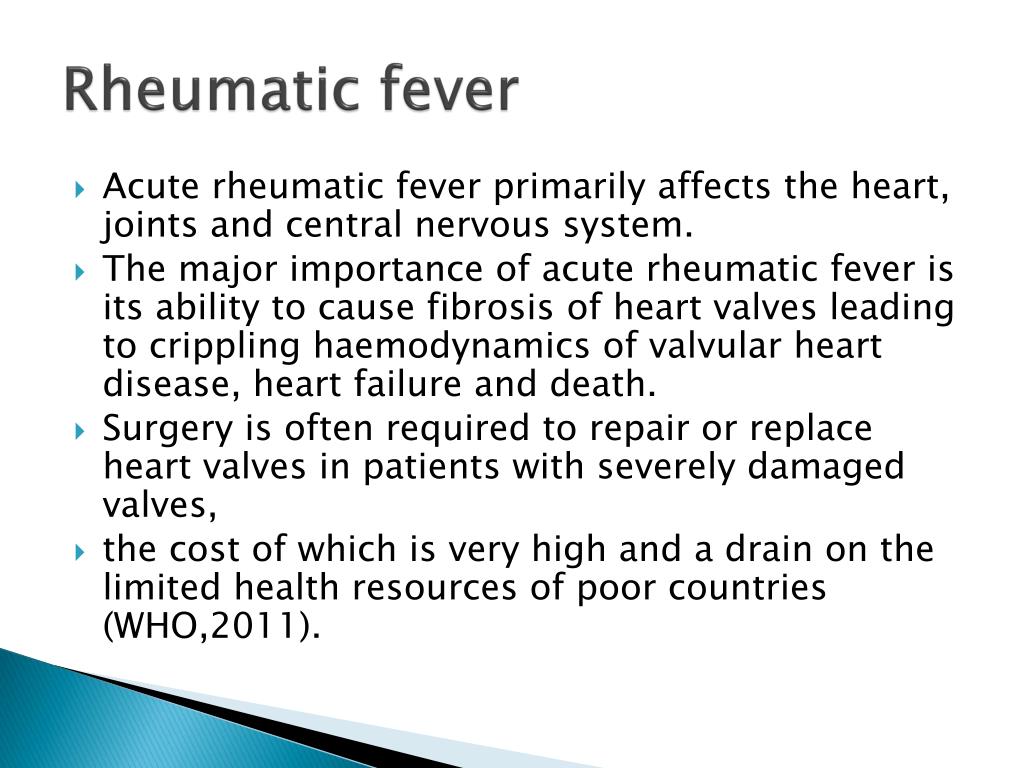
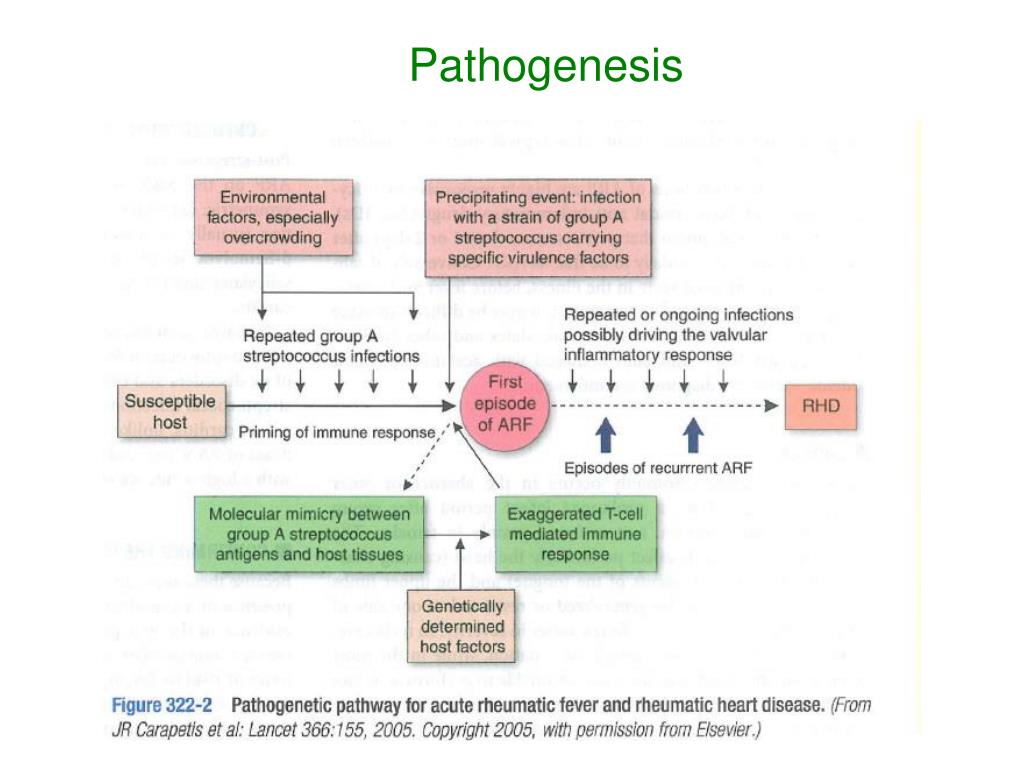

 Living in an area where it’s difficult to get medication or medical care may also put you at risk.
Living in an area where it’s difficult to get medication or medical care may also put you at risk.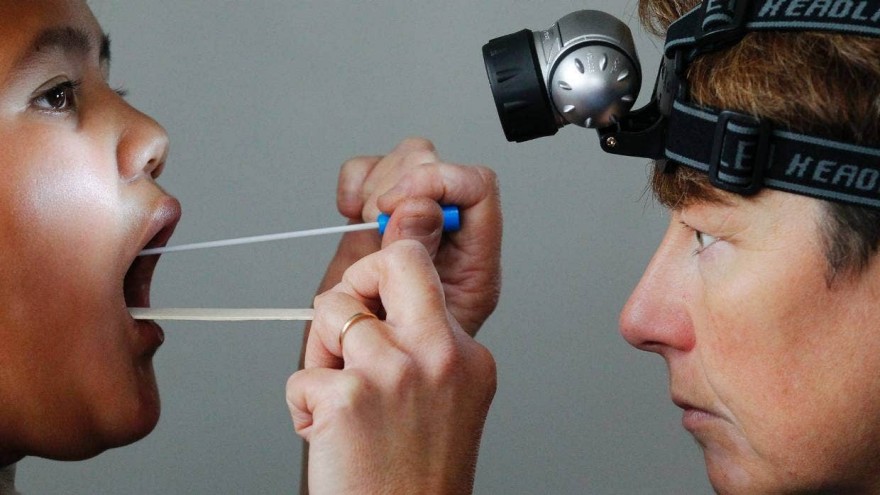
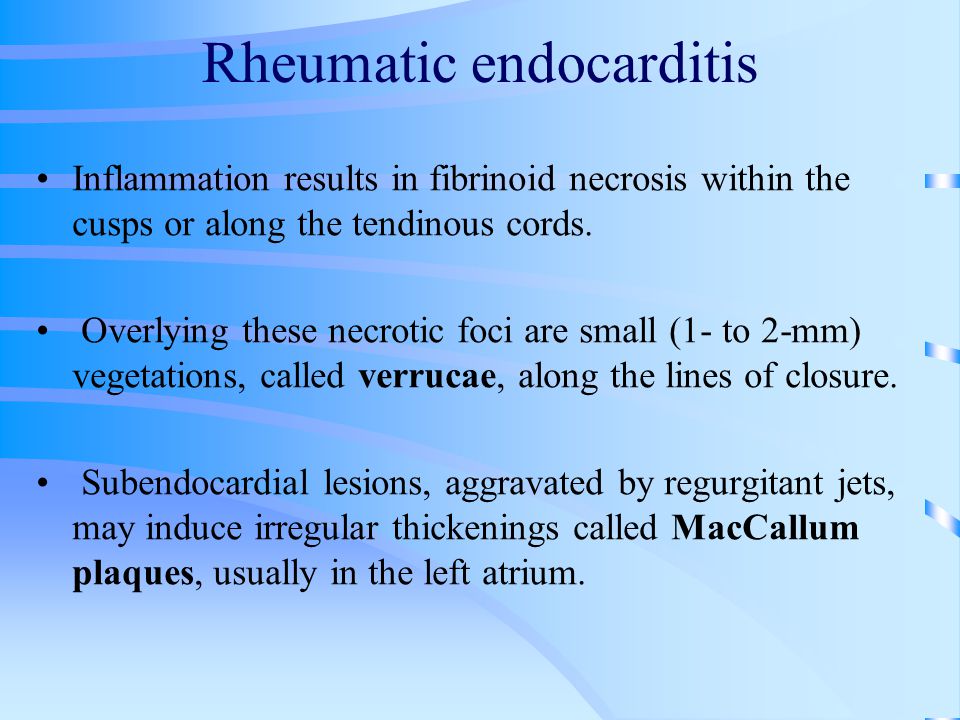 Some antibiotics are one injection (shot). Others you take by mouth for a week or more.
Some antibiotics are one injection (shot). Others you take by mouth for a week or more.